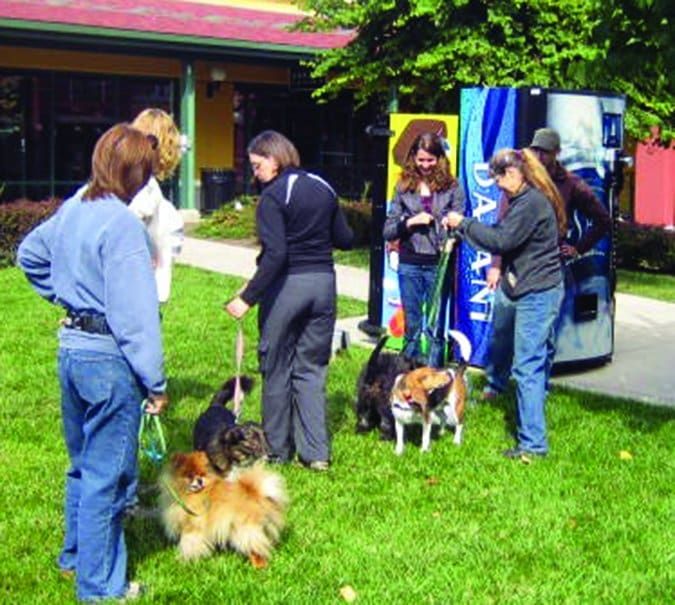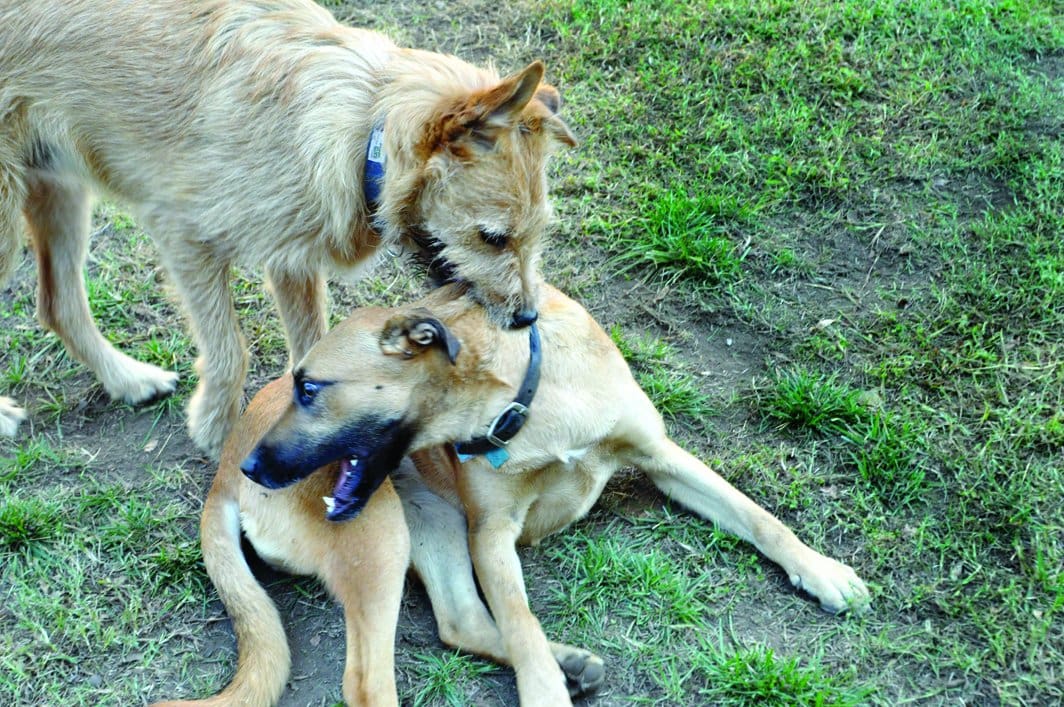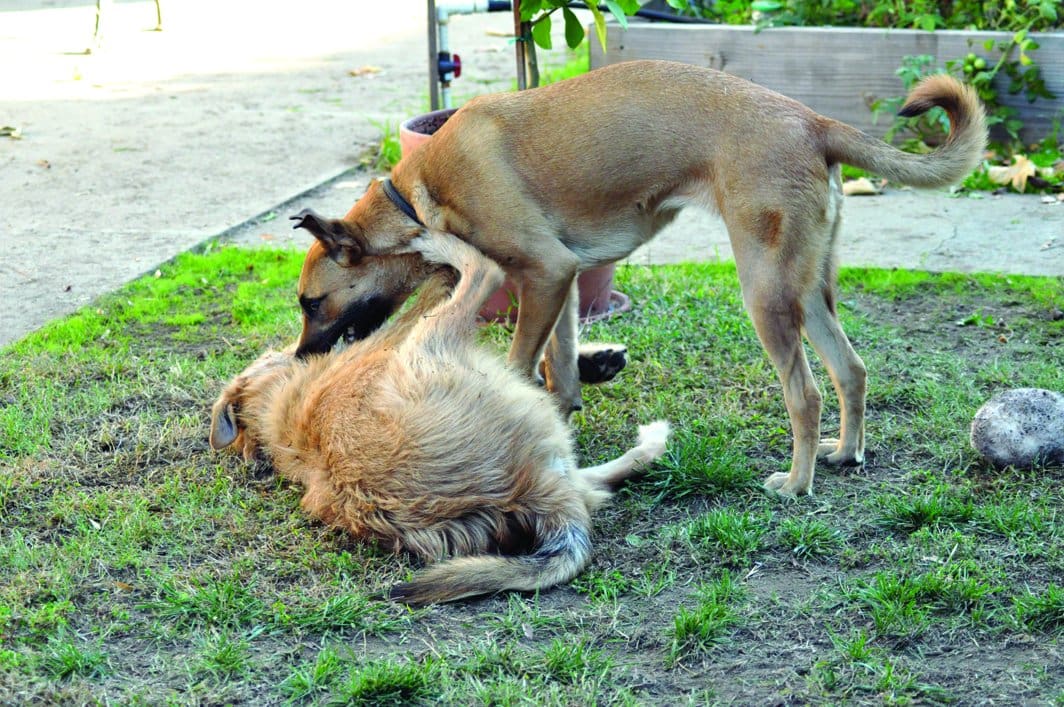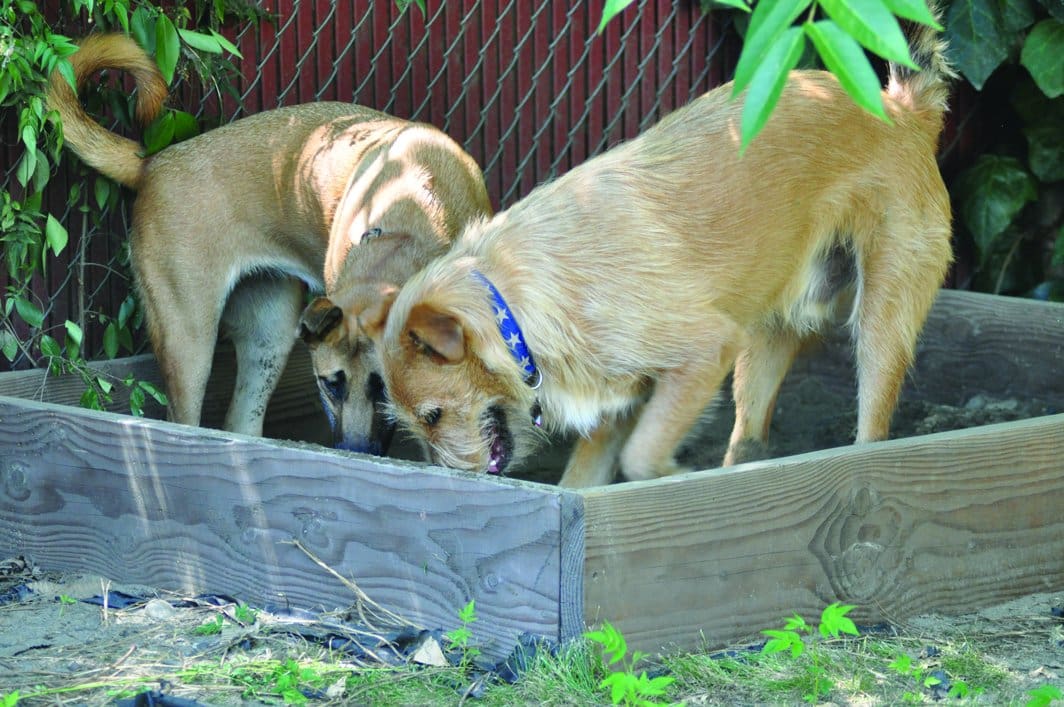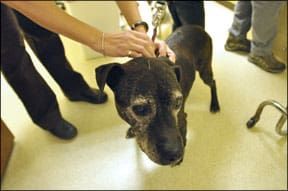Download the Full December 2009 Issue PDF
Do What You Can
Though I said that I’d share a story, in this issue, about a raid on a so-called “rescue” organization that was hoarding and neglecting dogs, I am not yet free to discuss it. The moment I can, I will, and I’ll explain then why I couldn’t talk about it now. For now, I’d just like to say that I wish I could award medals for bravery and compassion to the dedicated people I know who work in animal protection. The pay is low, the hours are long, the thanks are few, and the things they see on a daily basis are deeply disturbing.
288
Because I mightily appreciate the work that animal protection workers do, I try to give back, in a way that I can handle, without losing all faith in humanity or getting depressed about all the homeless pets in the world. I donate money to my local shelter whenever I can afford it. I don’t make donations to far-off programs; I feel better about donating to a program I can monitor with my own eyes.
I also give my shelter all the stuff left over from our reviews – food, treats, beds, leashes, collars, toys, and books. I take pictures of the animals and put together the shelter’s occasional newsletter (which has a not-so-secret fundraising agenda). When the director asked if I’d serve on the shelter’s board, I accepted. I walk dogs, and I reinforce sitting and other calm behaviors in all the dogs whose cages I walk by.
Whenever I tell people that I volunteer at my shelter, though, they always say the same thing: “How do you not come home with a dog every time you go there?”
Of course, I’ve adopted one dog from my local shelter, my darling Otto. And I’ve fostered one very sick puppy, and spent a small fortune nursing him back to health. But I’m trying to resist bringing more dogs home; I love the relationship I have with my singleton dog.
Instead, to my friends’ dismay, I’ve turned into a dog pusher. I tell everyone I know about certain dogs I’ve worked with at the shelter. I’ve put out the word that anyone I know who is looking for any type of dog should tell me; I’ll find them a perfect match: young, adult, or senior; short-haired or fluffy; small or large; indoor or outdoor; pure-bred or adorably mixed. Sadly, every type of dog comes through my local shelter at some point. But I’m happy to bathe, house, provide some initial training, and transport the dog to their living room, if they want!
I don’t know how long I can maintain my overzealous adoption efforts; already certain friends who used to be happy dog owners – but who are currently dogless – are starting to become wary about answering the phone when they see my number pop up on the caller I.D. (Sorry, Beth and Bill!)
Currently, my shelter (and probably yours, too) is participating in Iams’ annual “Home for the Holidays” campaign, with lowered adoption fees for every pet. Tell your friends! And consider going down to the shelter, just to take a look.
Training Your Dog Not to Jump Up
There’s a common misconception that dogs jump on people to establish dominance. Balderdash! Dogs jump on people because there’s something about jumping that is reinforcing for the dog – usually the human attention that results from the jumping. If you want your dog to stop jumping on people, you have to be sure he doesn’t get reinforced for it. Here are five things to do when your dog jumps on people:
1. Interrupt. Minimize the reinforcement your dog gets from jumping on someone by cheerfully removing him from the situation as soon as possible. To that end, you may want to leave a “tab” attached to your dog’s collar when he’s around people – a short (4 to 6 inch) leash that makes it easy for you to lead him away. These are available from Premier Pet Products (premier.com; 800-933-5595); or just cut off an old leash. Don’t leave the tab on your dog when he’s alone; he could get it caught on something.
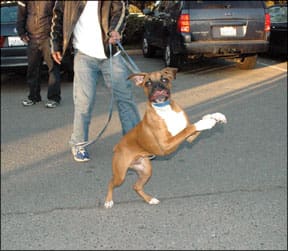
2. Manage. When you know your dog is likely to have trouble controlling himself, put his leash on before he can jump on someone. When you see the jumping-up gleam in his eye, restrain him to prevent the reinforcement he gets from the initial contact. Other useful management tools to prevent reinforcement include strategically located tethers, baby gates, doors, exercise pens, and crates.
3. Educate. Tell friends, family and even temporary acquaintances what you want them to do if your dog starts to jump up. Insist they not reinforce jumping up behavior – even those friends who claim they don’t mind! Educational options include telling them to:
• Greet your dog before he jumps, perhaps even kneeling to greet a small dog.
• Turn and step away from your dog until he sits, or at least has four feet on the floor, then turn back to greet the dog.
• Ask your dog to sit and reinforce by petting him if/when he does.
• Back away from your dog (if you have your dog on leash) and wait for him to sit before greeting or petting him. If he jumps up while you are petting him, simply stop the petting and take a step backward. Resume petting only if he sits.
• Toss a toy conveniently provided by you to redirect the dog’s behavior before the jump happens.
• Walk away from your dog through a gate or door and close it behind them to keep the dog on the other side.
4. Train. Of course you need to practice polite greetings in the absence of the exciting stimulus of guests and strangers by reinforcing your dog’s appropriate greeting with you and other family members. (See “Keeping Four on the Floor,” Whole Dog Journal May 2008). Be sure to take advantage of the presence of guests and strangers to reinforce your dog’s polite greeting behaviors while you’re managing with leashes and tethers.
5. Apologize/take responsibility. It’s your job to prevent your dog from jumping on people, even when they say they don’t mind. If your management efforts fail and your dog does jump up, apologize.
If in the process of jumping up he puts muddy pawprints on a business suit, snags a pair of nylons, knocks down a small child, or otherwise does some kind of property damage – even if the damage is minor – be responsible and make amends: pay for the cleaning bill, purchase a new pair of nylons, buy the child an ice cream cone, or do whatever you need to do to repair the damage. Then redouble your training and management efforts.
Canine Health News and Current Events December 2009
Warning: Paintballs are Toxic to Dogs
Ingesting paintballs can lead to seizures and even death.
My dog Ella and I spent an anxious night at the emergency clinic recently, after she found and ate paintballs while on our walk. She was off-lead at the time, so when I realized what she was doing, I had no way of knowing how many she had eaten. In fact, I did not immediately recognize the colorful, marble-sized gelatinous balls, and thought they were some kind of candy. It was only a few hours later, when she threw up bright turquoise, that I became concerned and investigated further.

Paintballs ingredients can include polyethylene glycol, dipropylene glycol, glycerol, and sorbitol, all osmotic laxatives, which can lead to hypernatremia (“salt poisoning”) when ingested in sufficient quantity. These ingredients also taste sweet, which is why dogs find paintballs so attractive.
Signs of paintball toxicity are usually neurological, a result of the movement of water out of the brain, leading to hemorrhage. The most common signs include vomiting, ataxia (loss of coordination), and diarrhea. These can occur as early as 30 minutes after ingestion, but more commonly show up within two to four hours. Other signs may include tremors, rapid heart rate, weakness, hyperactivity, fever, blindness, and seizures. Blood tests may show elevated sodium and chloride, low potassium, and metabolic acidosis.
The number of paintballs needed to cause clinical signs is unknown. In one case, a 90-pound Labrador Retriever showed signs after ingesting 15 paintballs. As few as 5 to 10 paintballs may cause signs in dogs weighing around 65 pounds.
Vomiting should be induced if it has been less than an hour since the paintballs were ingested (activated charcoal is not recommended). If the number of paintballs the dog ate is either unknown or relatively high for the dog’s size, or if any clinical signs are seen, it’s best to get the dog to a vet right away for testing and treatment. There, IV fluids are given to help dilute and flush out the toxins, and electrolytes and acid-base balance are monitored every two to four hours. Additional treatment may include drugs to control seizures and vomiting; warm-water enemas to help move the paintballs through the digestive tract more quickly (especially for dogs with elevated sodium levels); and therapy as needed for low potassium, high fever, or acidosis. While the ingestion of paintballs can be fatal, most dogs recover within 24 hours with proper care.
Because I was unsure how many paintballs Ella had ingested, and because of her small size (11 pounds), both my own vet and the Pet Poison Helpline I called recommended taking her to the emergency clinic right away and keeping her on fluids for 24 hours. Luckily, her electrolytes were never more than mildly out of range, and she had no further symptoms. Her bright green stool the next day showed evidence of only one paintball, but I don’t regret the precautions I took, which I’m sure helped her recovery and gave me peace of mind.
– Mary Straus
For more information: Paintball Toxicosis in Dogs www2.aspca.org/site/DocServer/ toxbrief1203.pdf?docID=1521
Veterinarians Join War on Cruelty
Univ. of Florida offers veterinary forensic science course
The field of veterinary forensics is growing. In 2008, the International Veterinary Forensic Science Association was founded; it will hold its third annual conference on veterinary forensics in Orlando, Florida, in May 2010. However, as yet, veterinary colleges provide little training in animal cruelty investigations for veterinary students. It’s tragic when testimony from a veterinarian can make the difference between a conviction or an acquittal in a cruelty case, and there are no qualified vets available to testify. Fortunately, educational resources for this area of expertise are about to get a boost.
The University of Florida has announced that in spring, under the guidance of Melinda Merck, DVM, senior director of veterinary forensics at the ASPCA, it will launch the nation’s first formal veterinary forensic science program. Dr. Merck assisted with the investigation into Michael Vick’s dogfighting activities, and her expertise helped put the NFL quarterback in prison. She is helping develop the University’s certificate program, which is part of its online master’s degree program in forensic science. The course will help veterinarians learn to recognize crimes against animals, and give them the tools to respond appropriately.
Approximately a dozen states mandate veterinarians to report suspicions of animal cruelty. Merck believes that even in those states where vets are not mandated reporters, they have a moral imperative to report.
According to Dr. Randall Lockwood, Ph.D., senior vice president of anti-cruelty field services at the ASPCA, a number of surveys indicate that every veterinarian will confront animal cruelty at some point in his/her career.
– Pat Miller
For more information: vetmed.ufl.edu/
FDA Issues Alert for Vetsulin
Owners need to check their diabetic dogs’ medication
On November 2, the FDA’s Center for Veterinary Medicine and Intervet/Schering Plough Animal Health began alerting veterinarians and pet owners to problems found with Vetsulin, a prescription insulin product used to treat diabetic pets.
Stability issues have led to variation in the amount of insulin contained in the product. Specifically, there may be too much crystalline insulin, which is the longer-acting component, and too little of the amorphous, short-acting insulin. This can lead to a delay in the insulin beginning to work, a delay in peak effect, or the insulin working longer than expected. The result may be either hypoglycemia or hyperglycermia.
Hypoglycemia (low blood sugar) is a medical emergency: if not corrected, it can be fatal. Symptoms of hypoglycemia can include disorientation, ataxia (loss of coordination or balance), weakness, lethargy, and seizures. If you suspect your dog is suffering from hypoglycemia, rub Karo syrup or honey on your dog’s gums or under the tongue and contact your veterinarian immediately.
Hyperglycemia is less of a concern, at least in the short term. It produces the same symptoms as are seen in diabetic dogs before beginning treatment, such as excess drinking and urination, increased appetite, and lethargy.
If you use Vetsulin to treat your diabetic pet, please contact your veterinarian right away about switching to a different product until these issues are resolved.
If your dog develops problems that your veterinarian believes could be linked to Vetsulin, they should be reported to the FDA and to Intervet/Shering-Plough Animal Health, the company that makes Vetsulin.
– Mary Straus
For more information: www.fda.gov/AnimalVeterinary/News Events/CVMUpdates/ucm188752.htm
Intervet/Shering-Plough Animal Health, 800-224-5318, vetsulin.com
Constructional Aggression Treatment (CAT) Can Improve Behavior
CONSTRUCTIONAL AGGRESSION TREATMENT OVERVIEW
What you can do…
– Read and watch videos about the CAT procedure and counter-conditioning to determine which approach is more appropriate for you and your dog.
– Talk to other dog owners and trainers (in person and online) to expand your knowledge base about the procedures.
– Look for a behavior professional experienced with the procedure to help you with it.
Aggressive behavior in their beloved companions is an incredibly challenging and upsetting problem for most dog owners to deal with. The problem is painfully public -and the public is equally free with accusations and advice for the hapless owner of a reactive dog. Many training “solutions” that people try are inhumane, ineffective, or both. Some owners respond by sequestering their dogs to their home “quarters” -sometimes for life.

In early 2008, I was excited to learn about a very new behavior modification approach for dealing with aggressive behavior in dogs. I described the technique, known as Constructional Aggression Treatment (CAT), in Whole Dog Journal’s May 2008 issue. “Modifying Aggressive Dog Behavior” explained the CAT program, and described my first experience (and positive results) using the technique. The subject was Juni, an eight-year-old Pit Bull-mix belonging to my friend and colleague, Jolanta Benal.
CAT was developed and tested by graduate student Kellie Snider for her master’s thesis, under the direction of Dr. Jose Rosales-Ruiz at the University of North Texas. The pair made quite a splash when they introduced CAT to the dog-training world, since CAT utilizes operant conditioning (negative reinforcement) to modify the subject’s behavior, rather than the more commonly used classical conditioning. (In classical conditioning, a positive stimulus is paired with an aversive one to deliberately improve the dog’s association with, and response to, the negative stimulus).
Since then I’ve had the opportunity to use CAT a number of times, with varying degrees of success. I’ve also participated in the ongoing behavior and training industry discussion about the technique. To say it’s a controversial approach to behavior modification is an understatement. But I still think it’s a valuable tool for use in some behavior cases.
The Principles of Operant Conditioning
Operant conditioning is a basic element of the science of behavior and learning. It says that all living things repeat behaviors that are rewarding to them, and avoid behaviors that make bad things happen. The four principles of Operant conditioning are:
1. Positive reinforcement (written in behavioral shorthand as “R+”): The dog’s behavior makes a good thing happen, so the behavior increases. He sits, and you give him a treat. He likes getting treats, so he sits more.
2. Positive punishment (P+): The dog’s behavior makes a bad thing happen, so the behavior decreases. He jumps up and you knee him in the chest (not recommended!) He doesn’t like a knee in the chest, so he jumps up less.
3. Negative punishment (P-): The dog’s behavior makes a good thing go away, so the behavior decreases. When he jumps up to grab the ball from your hand you hide the ball behind your back. He doesn’t want the ball to go away, so he jumps up less. (Negative punishment works best if you follow it with positive reinforcement for the behavior you want instead. When he sits you throw the ball [R+] so he sits more and jumps up less.)
4. Negative reinforcement (R-): The dog’s behavior makes a bad thing go away. Your puppy struggles when restrained, so you hold him until he becomes calm, and then let him go. Calm behavior makes restraint go away. He doesn’t want to be restrained, so he learns to be calm in order to make restraint go away (not recommended).
Because training methods that involve intimidation, coercion, and physical force can cause undesirable side effects, including fear and aggression, positive trainers use primarily positive reinforcement and secondarily negative punishment; they generally avoid the use of negative reinforcement, and especially avoid positive punishment. 0n those occasions where negative reinforcement may seem appropriate, it should be applied as gently as possible, avoiding a strong response from the dog. In the case of CAT, “gently” means presenting the aversive stimulus at sub-threshold intensity (otten this is “distance”) and being careful to increase intensity (decrease distance) only as the subject dog is can handle it.
CAT Controversy
The CAT approach is controversial among positive trainers for several reasons. The foremost is that the technique utilizes negative reinforcement.
To use negative reinforcement, something that is aversive to the dog is applied, and not withdrawn until the moment the dog changes his behavior in the desired way. For example, a dog pulls on the leash; this is a behavior the handler wants to stop. The handler increases the tightness of the leash, in a way that is uncomfortable for the dog; the tight leash is aversive. The dog moves back toward the handler (displays the behavior the handler wants), and the and the leash slackens, relieving the pressure and the dog’s discomfort.

Positive trainers try to avoid the deliberate use of aversives, for many reasons. To name just a few, the application of aversives can make many dogs “shut down” or lose interest in working with their handlers. They can increase a dog’s anxiety and fear. They can damage the relationship between the dog and his handler. In fact, in the past, I have been one of the louder voices in opposition to the use of negative reinforcement in “dog-friendly” training programs.
However, there are some sound reasons for using a certain type of negative reinforcement in a CAT program. Here’s how negative reinforcement works in the CAT procedure:
Most dogs who display aggressive behavior toward other dogs are trying to scare the dogs away; they are threatened or stressed by other dogs. In most cases, the behavior works; growling, barking, lunging, and snapping often makes the other dog leave -or at least, makes the owners depart with their dogs! From the “aggressive” dog’s point of view, the aggressive behaviors (growling, barking, lunging, snapping) have been reinforced: they worked, and the other dogs went away. And because behaviors that are reinforced get stronger, the dog is more likely to growl or snap at the next dog, and the next, etc.

In a CAT procedure for a dog-aggressive dog, the presence of the “other” dog is considered the aversive. The “subject dog” is deliberately exposed to another dog (the aversive is applied) in carefully controlled, low-intensity conditions, until the subject dog offers the desired behavior: some small decrease in his level of stress or tension. Then the aversive (other dog) is immediately whisked away. The idea is that the subject dog will realize that he can reliably make the aversive “other dog” leave if he exhibits calm behavior; each time he does this, he is rewarded -reinforced -by the quick exit of the other dog. His calm behavior around other dogs increases.
Most positive trainers (including myself) are opposed to the use of aversives, which by definition inflict pain, discomfort, fear, and anxiety on the dog. In CAT, however, you present the subject dog with an aversive stimulus that he is often exposed to anyway. For anyone who lives in a populated neighborhood and wants to take their dog out of the house, other dogs are not avoidable. Consider the dog-reactive dog who sees numerous other dogs daily on his walks around the block, or even from his own backyard, as dogs and their humans pass by on the sidewalk. People who walk their dogs in urban neighborhoods where dogs are popular may encounter more than 100 dogs each week.

Some positive trainers argue that counter-conditioning and desensitization (CC&D) are less-stressful tools that can be used to change how a dog-aggressive dog feels about other dogs -and it’s true, these are great tools that help many dogs. In a CC&D program, you present the aversive stimulus (another dog) while rapid-fire feeding high-value treats to the subject dog in an effort to change her association with the other dog. The idea is that she learns to associate the presence of other dogs with good things happening; she starts to feel better about other dogs. Eventually, one hopes, her behavior will improve as well.
CAT takes a different tack. The goal with CAT is to help the dog learn that a new behavior now works to make the neutral dog go away. In both methods, you present the aversive stimulus to the subject (reactive) dog, and in both methods, ideally, you present the stimulus sub-threshold -meaning the “other” dog is presented closely enough to the subject dog for him to notice the other dog, but far enough away so that he doesn’t respond with the reactive (growling, barking, lunging) behaviors. The “sub-threshold” presentation is an important part that sometimes gets missed in both CAT and counter-conditioning.
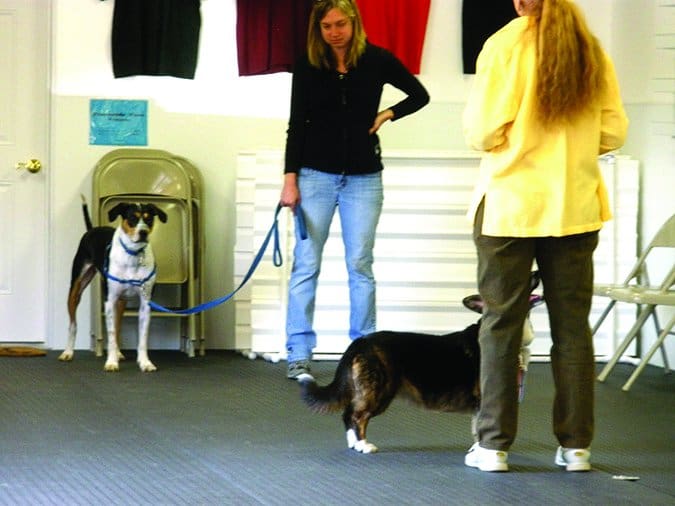
I may have fueled some of the opposition to CAT with my description of my first use of the CAT procedure with Juni in the May 2008 issue, and my subsequent release of the video footage of our sessions with him.
As I said, the goal in both a CC&D program and CAT is to present the aversive stimulus at a sub-threshold level, where the subject dog notices and shows some signs of stress, but isn’t barking and lunging or demonstrating other over-threshold (extreme) behaviors. But with Juni there was no sub-threshold; if he saw another dog at any distance, he barked and lunged.
Jolanta had done years of counter-conditioning with Juni, and was able to manage his behavior by feeding him in the presence of other dogs, but had reached an impasse in terms of actually modifying his reactivity. After watching Juni’s video, CAT co-developer Kellie Snider commented that Juni was one of the most difficult cases she had seen. We did get a lot of extreme behavior, and it made us all uncomfortable. And it should not be considered as representative of how CAT should look.
And yet, it worked. Jolanta reports that Juni’s behavior has continued to improve, and the quality of their lives together is greatly enhanced as a result of their CAT experience. Nevertheless, ideally, in a CAT program, the dog is not pressured by the aversive stimulus (other dogs) to the point that he erupts with over-threshold behaviors.
Other Critiques of CAT
Some CAT opponents argue that CAT is flooding, a behavior modification technique generally regarded as inhumane. Flooding is performed by introducing an aversive stimulus at full intensity and maintaining it until the subject achieves learned helplessness -he simply shuts down and gives up. That’s not what happens in CAT.
While a subject dog may try shutting down as a behavioral strategy, when CAT is properly carried out, the “shutting down” behavior is recognized as such by the handlers and isn’t reinforced. Signs of shutting down include lying down, consistently looking away from the neutral dog, and stopping all behavior. Reinforcement in the case of a dog-reactive dog comes when the neutral dog goes away.
When the subject dog tries shutting down, the handler of the neutral dog remains in place -still sub-threshold. The neutral dog is moved away only when the subject dog offers a small piece of a calm behavior that isn’t shutting down, such as opening his mouth, blinking, or glancing toward the neutral dog. “Look, dog,” the procedure says, “you can make the neutral dog go away by offering a new behavior. You don’t have to shut down; you are not helpless here.”
Others suggest that CAT, when it succeeds, is merely habituation -the subject dog gets used to the presence of the sub-threshold presentation of the neutral dog and stops reacting. There’s nothing wrong with habituation, and it probably does play at least a partial role as the subject dog comes to realize the neutral dog is not a threat. However, mere habituation doesn’t explain the remarkable switchover that occurs in some CAT procedures, when the subject dog begins demonstrating clear affiliative behavior (“Come closer, I’d like to get to know you!”) and is able to interact in a friendly manner with multiple dogs in fairly rapid succession, without habituating to each one.
Additional arguments against CAT include the high cost, the considerable block of time required for the initial procedure and follow-up training, and the difficulty owners may have in generalizing their dogs’ new behavior when they no longer have their CAT coach working with them. I acknowledge the reality of these concerns.
For private CAT sessions, I schedule three hours a day, three days in a row. I certainly don’t have clients flocking to my training center eager to pay the fee for nine hours of my time. For the relatively small pool of clients I have done CAT with, even many of the ones who have had great success have found it very challenging to generalize the behavior with their dogs back at home.
While Snider strongly recommends doing the procedure in the dogs’ own environment to avoid some of the generalization challenges, many of my clients travel long distances and stay here for the three days, and it’s not financially feasible for them to transport me to their homes and pay for three full days of my time. So we do it at the training center, and help clients identify ways to practice when they get home.
CAT Is All About Manipulating Reinforcers
The key to a successful CAT procedure is being able to identify, and manipulate, whatever it is that’s reinforcing the dog’s unwanted behavior, in order to be able to reinforce a different, more desirable behavior. It’s clearly reinforcing to fearful dogs to have the scary thing -dog, human, or whatever -go away. But that’s not always the case. If a CAT procedure isn’t working, you may have to re-evaluate your assumption of how the dog is being reinforced, and alter the procedure accordingly.
Some of the easiest CAT procedures I’ve done have involved dogs who were reactive because they wanted to be social with the approaching dog, and their frustration with being denied that pleasure turned into barking and lunging on-leash behavior. With those dogs, we do a “reverse” CAT procedure. They are reinforced when the neutral dog comes closer, because they desperately want to greet the other dog. In that case, calm behavior makes the neutral dog-and-handler come closer, while reactive behavior makes the neutral dog leave.
CAT Camp
My most recent CAT encounter was a four-day workshop held in early October 2009, at my Peaceable Paws training center in Fairplay, Maryland. The group turned out to be a perfect microcosm of my experiences with CAT in the past 18 months.
I had three dog/human teams registered for the workshop, and four auditors, as follows:
- Melanie and Adam Kornides, of Alexandria, Virginia, with their Beagle, Charlie. The Kornides had worked with Charlie at All About Dogs in Woodbridge, Virginia, doing counter-conditioning and desensitization in a Reactive Rover-style class for Charlie’s dog-dog reactive behavior. They felt they were stuck in their modification program; Charlie would still bark and lunge at most dogs in his neighborhood when he first spotted them. They were looking for a new approach.
- Katie Ervin of Hagerstown, Maryland, with her four-year-old Dobie/Hound mix, Harley. Katie is a Peaceable Paws trainer and owner of 4-Legged Friends pet-care service. Katie had done a great deal of counter-conditioning with Harley for his dog reactivity, and while she excelled at managing Harley’s behavior in the presence of other dogs (he has several rally titles), he could still be explosive if dogs got too close.
- Pam Courtleigh of Rockport, Massachusetts, with Bliss, a Chow-mix street-dog from Puerto Rico. When Bliss was found and rescued as a four-month-old pup, she had a deep laceration running the length of her back. Bliss was reactive to humans, not other dogs. Given the abuse she probably suffered as a street puppy, her mistrust of strangers wasn’t surprising. Pam had done an excellent job of helping Bliss learn to tolerate people, but the strikingly beautiful black dog was still uncomfortable and would sometimes snap if someone she didn’t know well reached over her head to pet her. Pam was worried her dog might one day bite someone.
My auditor/helpers were Judy Archer-Dick, of Spencerville, Indiana; Anne Gouiller-Moore, of Blackburg, Virginia; Connie Snavely, of Madison Heights, Virginia; and Silke Wittig, of Orangeville, Pennsylvania. All are trainers in their own right, eager to increase their education and experience with the CAT procedure.
Like others who have used, observed, or heard about the procedure, they had many questions and comments, and wanted more experience with CAT to help them sort through the controversial issues for themselves. Their observations added value for the working participants -multiple eyes, brains, and mouths can see, process, and share more information, and contribute to the sometimes-lively discussions. We also made good use of our auditors by drafting them as neutral dog handlers and photographers during the procedures. It was a highly educational experience for all.
Each CAT dog worked for one three-hour session for each of the four days, with a 15-minute break for canines and humans after about 45 minutes of work. Given the finite number of hours in a day, we worked two dogs simultaneously in one time slot each day (in separate locations), and one dog alone. Auditors chose which dog(s) they wanted to observe.
- Bliss: This medium-sized black dog first showed signs of discomfort at my approach when I was about six feet away. We started our work there, retreating when she showed some sign of relaxing, waiting for a 15-second recovery period, and then returning. Although she seemed to quickly accept my presence, I wasn’t sure she found my departure particularly reinforcing, and the auditors reported the same observation. Her affect was very flat -a common persona for Chows -and we all sensed we’d wait for a long time, if ever, to see affiliative behavior from Bliss in a CAT procedure.
We decided to experiment with a squeaky toy, which Bliss liked. I began squeaking it once and tossing it to her as I left, to make my departure more reinforcing to her. In essence, we were adding a positive association with my presence, and positively reinforcing my departure by providing something she liked. We were no longer doing CAT, but in very short order Bliss decided she liked me. When I sat in a nearby chair she came and rested her head on my knee. This, according to owner Judy, was her sign that she had accepted me, and indeed, from that day forward, I was her friend and could pet her anywhere without caution, including over her head.
If Bliss was that easy with positive reinforcement, it made little sense to me to painstakingly pursue the CAT procedure. Her owner agreed, as did the rest of the group, and for the remaining days of the workshop we gave Bliss positive associations with humans, and positively reinforced her for appropriate human-related behaviors. She quickly befriended the other workshop attendees, and on Day 4 accepted treats from several strangers at a nearby shopping mall. Judy also did counter-conditioning with her at the mall as shoppers who showed no interest in the dogs passed by.
In a follow-up report shortly after the workshop, Judy assured us that Bliss was doing well back at home with her ongoing counter-conditioning and positive reinforcement work.
- Harley: Like Juni, Harley had years of counter-conditioning and desensitization work under his collar. He had selected avoidance behavior as his primary line of defense in the presence of other dogs; if they got too close, he looked away. This behavior had been reinforced by Katie’s high rate of treat reinforcement as she passed by other dogs in close quarters at training classes, Rally trials, and other doggie events. Harley became reactive only if dogs invaded the space a foot around him. Katie was hoping to extinguish even that reactivity with the CAT procedure.
This was a challenge. Misreading his avoidance behavior for calmness, we approached to a distance of 20 feet with my Cardigan Corgi, Lucy, and waited for a sign. Nothing. Harley looked anywhere but at Lucy, but didn’t appear unduly stressed. We worked our way closer, still without any behavior that felt like progress. Finally Harley started lying down, a sure sign of shut-down. Katie tried to jolly him up in between sessions, but he would quickly lie down again, and it was clear we were making no headway. Time to regroup.

Putting our heads together, we realized that Harley did glance at Lucy when she was at the opposite end of the 80-foot room. We need to work with Lucy farther away, not closer. Just because he wasn’t exploding didn’t mean Harley wasn’t over-threshold. Avoidance was his “extreme” over threshold behavior. “Duh,” we said as we collectively slapped our foreheads at this epiphany.
We started over with Harley on Day 2, with Lucy 80 feet away, reinforcing him by increasing distance when he looked at her. We were able to reduce the distance fairly quickly initially, to about 40 feet, and then more slowly, to about 20 feet. We started seeing more active interest from Harley as Lucy approached, and tail wags as she departed. It was working!
Katie still had to do a lot of jollying in between approaches to keep Harley engaged, but he wasn’t trying nearly as often to lie down. Harley continued to make slow progress over the final two days of the workshop, but he never showed strong affiliative behavior to any of the neutral dogs. Katie reports that she hasn’t had much opportunity to practice CAT with him since the workshop; she continues to manage his behavior with treats when near other dogs.
- Charlie: This little Beagle was the star of the CAT workshop, and a textbook subject. It was as if he had read the research paper. On Day 1, my associate, Shirley Greenlief, did approaches with Bonnie -my very friendly, 35-pound Scottie/Corgi/Poodle. They quickly reduced distance and ended the day about 10 feet apart. By Day 2, Charlie was doing parallel walking with Bonnie, and on Day 3 he interacted with Bonnie and Missy, my bouncy Australian Shepherd.
When we tried doing approaches with Bliss, we discovered that Charlie was more uneasy with her. Perhaps it was her more serious demeanor, her sharply-pricked upright ears, the tail that curled over her back, or a combination of these, but Charlie was clearly tense with her, and we were able to approach within only about 20 feet.
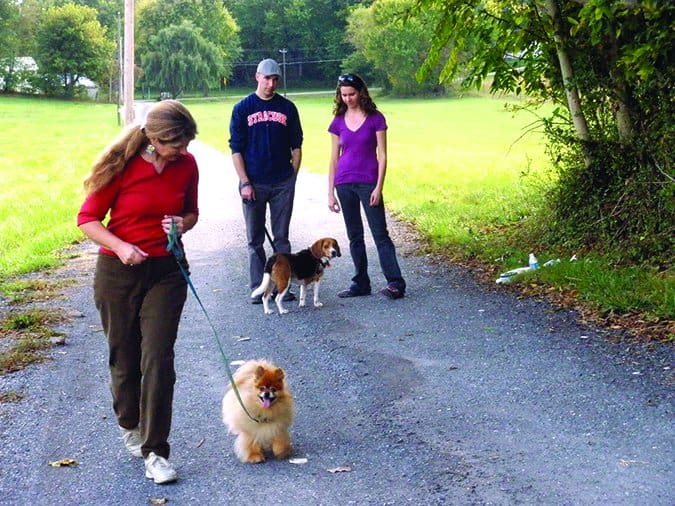
On Day 4, at the mall, Charlie delighted us all, interacting easily with the dogs he had met previously at the training center. He was still tense about approaches from Bliss, as well as from Myah, Shirley’s Siberian Husky, who, while demonstrably more relaxed and friendly than Bliss, also had sharply pricked ears and a curled-over-the-back tail. Charlie immediately accepted Lucy, whom he hadn’t previously met; she has sharp-pricked ears and a curled tail, but is half the size of Bliss and Myah. By the close of the final session, he was able to relax on the grass with all six dogs (Bonnie, Scooter, Missy, Lucy, Bliss, and Myah, and didn’t react to a couple of random dogs whose owners were walking them at the mall. Success!
Charlie’s owners have continued to work with CAT in their Washington, DC, neighborhood, under the guidance of CAT-experienced trainer Penelope Brown, owner of Phi Beta K9 School for Dogs, who has assisted me with several CAT procedures, including Juni’s. They report continued progress and success with Charlie’s CAT program at home.
When to Use CAT
Like much of what we do with our dogs, CAT is useful in some cases, but not others. It’s a useful tool to have and consider when appropriate, but I’d never say it should be used with every dog who has aggressive or fearful behaviors.
I’m often asked how I decide when to do counter-conditioning with a client and when to choose CAT. While Kellie Snider suggests that CAT works better if you haven’t tried other modification approaches first, I tend to use it with dogs for whom counter-conditioning hasn’t modified their dog’s behavior as much as they’d hoped. I freely admit I’m still heavily biased toward counter-conditioning, as evidenced by the fact that I’ve done maybe as many as a dozen CAT procedures in the last 18 months, while I do counter-conditioning programs with several new clients each week. I almost always try counter-conditioning first, and if we don’t see the improvement we hoped for, perhaps suggest CAT as an alternative somewhere down the road.
I think CAT is a helpful technique for dealing with some issues, but an especially valuable procedure for introducing a reactive dog to one specific dog. If your dog is reactive toward other dogs and you want to bring home a new canine family member, CAT can facilitate the introduction and new living arrangement. No worries about generalization -your dog only has to come to like the one new dog you’re bringing home.
In fact, when we adopted our new Pomeranian, Scooter, last spring, I was going to use CAT to introduce him to Dubhy, our dog-reactive Scottie. But Dubhy took one look at Scooter, got all soft and mushy, and welcomed Scooter into the Miller family with open paws. Dubhy had lived with a Pomeranian previously and the two had been good friends. I think Dubhy remembered.
Pat Miller, CPDT, is Whole Dog Journal’s Training Editor. Miller lives in Fairplay, Maryland, site of her Peaceable Paws training center. Pat is also author of The Power of Positive Dog Training; Positive Perspectives: Love Your Dog, Train Your Dog; Positive Perspectives II: Know Your Dog, Train Your Dog; and Play with Your Dog.
Managing Your Dog’s Stress – A Holistic Approach
As your pet’s human companion, you want to do the best you can for him or her, as do the clients who come to my clinic. In my opinion, a holistic approach will give you new tools to ensure that your pet stays as happy and well as possible. I would like all animal caretakers to learn a new perspective on health and healing – one that respects the best that natural health care and mainstream medicine have to offer, yet goes beyond the limitations of both. This new way of thinking will take you beyond fixing immediate problems and will give you a fresh and comprehensive take on prevention.

Photo by Jeanette Johnstone
The holistic way of thinking also involves seeing your role and your veterinarian’s role in a different way. Because you are the person closest to your dog, you are in the best position to influence her well-being. You have the primary responsibility for making decisions that affect her quality of life. In my view, a veterinarian is a coach who provides expert opinions, perspectives, and advice about how to support your pet’s wellness. At times, he may point you toward further resources and even toward other types of health care professionals to help you do that.
The holistic way of thinking that is so important to your pet’s wellness begins with the way we look at health.
Holistic health care: more than a set of treatments
Mainstream medicine has significantly influenced how people in the West think about health and healing. But since the 1970s, natural health care methods have steadily gained acceptance as effective, safe, and life-affirming ways to support the wellness of both humans and pets. These natural approaches are often referred to as holistic. In fact, the word holistic has picked up so much cultural momentum that it’s used to sell products and services ranging from pet foods, shampoos, and beds to Sophie’s weekly swim at the neighborhood dog spa. This encouraging sign shows that people want to do the best they can for their pets and the environment. But do all the claims that these products and services are holistic bear out?
For example, even the best foodstuffs can’t be holistic (let alone natural) if most of the life has been cooked, dried, sanitized, and packaged out of them. Neither can a so-called herbal pet shampoo or grooming aid be completely wholesome and safe if it also contains industrial chemicals known to be harmful for a pet. When it comes to health care, many people believe that a practice is holistic if it uses homeopathy, acupuncture, nutraceuticals, chiropractic, massage, or other natural therapies. But my clinical experience has taught me that no therapeutic remedy, supplement, or system is holistic in itself. The holistic way cannot be defined by its remedies alone. In fact, any therapy can serve either the goals of the holistic way or those of mainstream medicine. And those goals are very different.
What is the new holistic way?
Based on more than four decades of veterinary practice, I want to take holistic health care into new territory. This is why I call my approach the new holistic way. I don’t claim that all the ideas in this book are new. You will find many of them familiar if you already use modalities that are not part of mainstream medicine. Others have worked hard to promote these approaches, and I acknowledge that I am building on their excellent work. However, in my view many of these methods and concepts remain locked in and shaped by the historical contexts out of which they arose, as does mainstream medicine itself. Although they undoubtedly served well their original times, places, and cultures, today they are thrown together in a new context. As many different approaches to health care intermingle in this context, including traditional, indigenous, energy based, and recent developments in Western science, I see a synergy emerging.
To unleash this synergy, I offer a way of thinking that links the many different approaches to health care with our growing knowledge of how stress affects well-being. This is why I emphasized earlier that the new holistic way is not defined by its remedies alone. Instead, it guides us in choosing and applying whatever therapies or combination of therapies will work to address the health challenges that dogs and cats experience in contemporary life.
This new way of thinking is based on the premise that every expression of health – from wellness to unwellness to illness – emerges from the interaction of two factors. The first factor is the living terrain, which is the body itself, and the second is stress. I am convinced that better pet care will result when pet lovers and veterinarians understand that stress is the underlying cause of every form of health problem a dog or a cat can have.
In modern life, stress challenges the living terrain in infinite ways. Stress and the living terrain take part in a dynamic, never-ending dance from which all health outcomes flow.
By focusing on the relationship between a dog’s stress and the living terrain, the new holistic way strives to achieve the following goals:
1. Support the health of the living terrain.
2. Free up blocked energy.
3. Consider the whole individual.
4. Look for the hidden stress factor that’s causing the problem.
The living terrain: the foundation of wellness
When a client brings a pet into my clinic, my aim is to help that animal thrive the way she is meant to. Nothing delights me more than seeing a dog become radiant with enthusiasm for life, with shining eyes, glistening fur, a great appetite, and legs that move effortlessly with synchronicity and grace. My satisfaction as a veterinarian comes from helping my patients go from whatever condition they started with toward the highest degree of wellness they can attain.
The new holistic way begins and ends with supporting the condition of our pets’ bodies – the living terrain.
In holistic thinking, wellness springs from the living terrain. Densely packed and highly complex, the living terrain consists of tissues that are made up of billions of living cells. The cells organize together to form organs, hormones, the nervous system – every part of the body – and from these, all the body’s functions arise. Zooming in even closer for a moment, we can see that every cell is made up of molecules. Molecules are tiny bundles of energy – and energy is a superstar in the holistic view of life. We’ll come back to the great importance of energy in a moment.
The living terrain is dynamic and alive. That’s why I call it the living terrain. It has an integrity – an intelligence, we might say – of its own. It reaches for life just as a flower or tree reaches toward the sun. It constantly affects the environment of which it is a part, and the environment affects it in turn. All of us as individuals – whether canine, feline, or human – express ourselves through, and are one with, our own living terrain.
In a marvelously orchestrated and brilliant way, all aspects of a dog or cat’s living terrain – his molecules, cells, tissues, organs, and systems – communicate and cooperate with each other to allow him to express himself according to his nature as a living being. We refer to this communication and cooperation between all aspects of the living terrain as synergy. To support the health of the living terrain, the new holistic way focuses on all of these dimensions: the molecules, cells, tissues, organs, and systems; the synergistic communication among them; and the energy that manifests and powers them.
Nourishing and supporting our pets’ living terrains appropriately in everyday life is the single most important thing we can do for their wellness. Festus and Samson’s health needs don’t end the moment they leave my clinic. The new holistic way’s number one priority is to keep the living terrain, including the immune system, as well as possible all the time. If Festus and Samson are bursting with wellness when they walk out the door to go home, they won’t sustain that condition unless their people look after them in ways that allow their immune systems to remain strong. I consider it part of my job as a veterinarian to coach my clients about how to do that.
The vital importance of free-flowing energy
The health of the immune system, like that of the rest of the living terrain, depends upon how well living energy flows through it. In the new holistic way, all paths lead back to the fundamental importance of energy.
I first became aware of the role of energy flow to the living terrain’s remarkable power to heal itself when I tried to help a German Shepherd Dog who had a bad leg wound that would not mend. Before I saw him, the dog had been taken to other clinics and been put through the gamut of mainstream therapies, including many different antibiotics. One dedicated vet even tried to surgically reestablish normal tissue in the area, after which the wound partially healed, but then it broke down and reopened again. When I saw it, it had formed a weeping, seeping, fistulous tract. There was no foreign object in it, no infection, no known reason why it wouldn’t heal. But it would not.
Because I wanted to try stimulating the body’s own ability to heal rather than using methods that acted directly upon the wound, I gave the Shepherd an arbitrary dose of homeopathic Silicea tissue salts. Over a short period of time the wound healed up completely. I was thrilled to see a safe, subtle, natural substance such as this work so effectively.

I realized that the wound had not healed previously because the dog had an energy block that affected the area. Neither antibiotics nor surgery had done the trick; the fistula did not resolve until we used a therapy that removed the block on the subtle energy field. If we hadn’t moved out the block, the healing would not have happened. Somehow, the homeopathic tissue salt enabled the healing process by releasing the block so that energy was able to flow freely again.
Everything is made of energy, and energy powers everything. Nearly every ancient or traditional healing system has recognized this. Each tradition has its own understanding of where energy comes from and what it means. Whether they use the words chakras, chi, life force, spirit, or electrons, people are talking about energy. Whatever we may call it, free-flowing energy and the crucial role it plays are front and center in the new holistic approach to health care.
Looking through the lens of our Western mind-set, we have been slow to accept energy as a factor in health care. We think that if we can’t see it, it isn’t really there. Yet we accept other powerful forces that we can’t see. For example, when was the last time you saw the wind? But we see and feel its tremendous effects as it bends trees, flaps the laundry on the line, pushes clouds around, or buffets the cars we ride in. It’s the same with gravity. We don’t see it, but we feel it and know it’s really there. It’s the reason we have to be careful climbing stairs and must hold pets or babies securely in our arms. As we age, we experience its effect on our bodies. Like the wind and gravity, the energy that moves us and forms our bodies really exists. We can’t address our health needs if we ignore it or fail to acknowledge it.
Nothing happens without energy. The appliances that make a modern home comfortable depend upon its free and proper flow. When too little electricity flows, appliances slow down and grind to a halt. If too much electricity surges through them or flows in the wrong way, they short-circuit and malfunction or burn out altogether.
Like the electricity that flows through a house, the energy that flows through living beings keeps vital systems functioning at their best. An animal’s health and well-being depend upon her life energy being able to flow as it’s meant to. When her energy doesn’t move well, physical problems begin to develop at the cellular level and interfere with the functions of tissues, organs, glands, and other crucial aspects of the body – as happened with the German Shepherd whose wound would not heal. This is why holistic health care focuses on freeing up any blocked energy within a pet’s living terrain.
In dogs, cats, and people, energy expresses itself not only physically but also emotionally and mentally. (The mental aspect is especially developed in humans.) Emotional and mental states affect the living terrain of our bodies, and the terrain, in turn, influences how we feel and think. Again, we see the wonderful synergy that manifests in each living being. When energy flows as it’s meant to, our pets experience the balance of homeostasis. They feel the pleasure of life and the joy of good health. But when something blocks the physical or emotional energy that should flow through their living terrain, their wellness deteriorates. Then, signs and symptoms show up to tell us something is wrong.
But signs and symptoms manifest differently in every individual dog, cat, or human. This brings us to the next goal of the holistic way.
Taking individuality into account
Because signs and symptoms present themselves differently in everyone, the holistic way regards each patient as an individual who has a unique response to stressors that may challenge her living terrain.
Sometimes two individuals will have the same illness and will display it in different ways. Other times, they will have different illnesses but show exactly the same symptoms. I had a chance to see this for myself when two dogs, both previously diagnosed with Cushing’s disease, were brought to my clinic within a few weeks of each other.
The first case was that of a Wire Fox Terrier called Casey who had typical signs of Cushing’s and lab results that backed up the diagnosis. Cushing’s disease involves overactivity of the adrenal gland and is often associated with a brain tumor affecting the pituitary gland. It typically reveals itself through excessive eating, drinking, fluid retention, and urination, and the patient becomes weak and lethargic. Because veterinarians don’t yet know how to cure it, we try to control the condition and make the patient more comfortable for the time she has left. This is usually done using invasive pharmaceutical drugs that can have severe side effects.
Casey’s people brought him to me because they’d been told that he had to be put on a drug that would have damaged his adrenal glands, and they didn’t want to go that route. But there is another drug, used for treating Parkinson’s disease in people, that will sometimes control Cushing’s cases. I was hopeful it would work for Casey so we could avoid the other options. To the relief of my clients and me, it did work. With the help of the less risky pharmaceutical we were able to keep Casey going for a couple more years until he passed away.
The second case involved Rosie, an Airedale who had the same symptoms as Casey. Even the lab reports of the two dogs matched. Rosie’s people were aware of the standard Cushing’s drugs and didn’t want to risk her suffering their side effects, so before they agreed to use them they came to me, hoping for an alternative.
My first inclination was to approach Rosie’s case the same way I had approached Casey’s case. But as her people and I discussed her history, important information emerged. This dog was living under tremendous emotional stress. Josie and Rob were working out a marital separation, and they shared custody of Rosie by shifting her back and forth between them.
As we talked, we realized that her symptoms became much worse when she stayed with Rob and eased off when she stayed with Josie. Something didn’t add up – a dog would not have classic Cushing’s disease in one environment but not in another. So, given Rosie’s circumstances, I decided to try a different tack: we could experiment to see whether we could improve the dog’s condition by reducing her environmental stress. At the same time, we would aid her living terrain with gentle, supportive remedies.
Josie and Rob agreed to try letting Rosie stay full time with Josie. I supplied them with raw adrenal supplements combined with appropriate herbs, as well as homeopathic and flower remedies. Once all these changes were in place, Rosie’s symptoms completely disappeared.
I was delighted that we were able to solve such a challenging problem by modifying the environment instead of using powerful drugs. And it was evident that although Rosie’s symptoms mimicked Casey’s, she didn’t have Cushing’s at all. Instead, her adrenal glands were under stress induced by an emotional situation. If I’d looked solely at the similar signs and symptoms of the two cases, I would have treated them the same way and unnecessarily subjected Rosie to invasive drugs. The individual characteristics of these two dogs and their underlying circumstances made all the difference in the world.
When a pet’s health deteriorates, the new holistic way guides us to focus on the aspects of her specific case. We consider her genetic background; her physical, environmental, social, and emotional history and present circumstances; and her particular signs or symptoms. Such information provides clues about the underlying cause of the patient’s stress, as it did with Rosie. It also helps us gauge how her immune system has responded to the problem.
Managing a Dog’s Stress
I am convinced that better pet care will result when pet lovers and veterinarians understand that stress is the underlying cause of every form of health problem a dog or a cat can have.
In modern life, stress challenges the living terrain in infinite ways. Stress and the living terrain take part in a dynamic, never-ending dance from which all health outcomes flow.
Acute stress is immediate and intense. It can be caused by an accident, a sudden infection, or a powerful toxin. Although it’s usually short-lived, if it’s too much for our pets to handle, it can have very serious consequences. But if a pet is healthy, she will overcome most acute stressors. You can help your pet by preventing acute stress in whatever ways you are able and by supporting her living terrain so that if a challenge confronts her, she can successfully hold her own.
Chronic stress, on the other hand, can be a real drag on wellness. Often, when a dog or cat with a serious illness such as cancer is brought to my clinic, I will discover that she has been suffering from chronic stress due to a long-standing cause that had been neither identified nor addressed.
Once a stressor is recognized and modified and the living terrain given support, a pet will improve either emotionally or physically or both, and at least some future problems will be prevented. But because of the toll chronic stress takes on the living terrain, many of these pets will need ongoing support to maintain their best level of wellness. It’s worth the effort – it’s wonderful to see a pet who has suffered from chronic stress become both happier and healthier.
Because it is prolonged and persistent, chronic stress can wear down a pet over time. Its effects manifest differently in each individual. One animal may show it through a behavioral issue; another, through a gastrointestinal disturbance; and a third, through unexplained weight loss. It may also produce problems with organs or glands, such as heart disease or diabetes. Chronic stress tends to need ongoing support, but the right approach will ease, and sometimes even resolve, the health care issues it may cause.
Chronic stress can also compromise a pet’s health indirectly. For example, she may become more susceptible to infections, and eventually to degenerative conditions such as cancer or allergies. These conditions often vary in intensity. For instance, allergies tend to come and go depending on the season or the availability of irritants; arthritis is affected by damp weather or too much or too little exercise, and cancerous growths don’t always grow at a steady rate and sometimes actually get smaller. Although appropriate health care will improve most of these problems, they can be very challenging to address. All of them depend on the strength of the other major factor that plays a starring role in maintaining our pets’ health: the immune system.
Overall, both the stress response system and the immune system depend on an abundant supply of energy, which, in turn, they burn up as they carry out their functions in keeping our pets alive. Each system does best if the body’s living terrain is in good shape to begin with, and they don’t do so well if it isn’t. Negative stress, whether chronic or acute, makes both the stress response system and the immune system less effective in protecting our dogs and cats. On the other hand, recent research has shown that reducing negative stress has the effect of boosting the immune response. In sum, reducing stress not only eliminates the cause of a dog or cat’s unwellness or illness, but also, through boosting the immune system, it improves her state of wellness.
Whether stress is physical, emotional, or mental in origin, it affects every aspect of our pets’ health. We’ve seen that positive stress boosts the immune system and general wellness, while negative stress depletes energy, damages tissues, and pushes the body until it is unable to eliminate cellular by-products that can damage it. Too much negative stress can make a cat or dog vulnerable to viruses, bacteria, toxins, or parasites; weaken organs and vital systems; or turn her body against itself through autoimmune disease or cancer. Stress can cause an almost infinite range of trouble for a pet and only a health care perspective that’s broad, inclusive, and flexible can address the possibilities. By taking a holistic approach and learning how to manage our pets’ stress, we can make an enormous difference to their well-being and happiness.
The health care of the future
Clearly, whether we support our pets’ health care holistically depends not so much on which modalities we choose – or whether we buy natural products, for that matter – but on why and how we use them and what we hope to achieve with them. And while both natural and mainstream medical tools have a place in holistic practice, the mainstream way of thinking about health leads to a very limited approach to health care. By thinking holistically, we can assess situations more broadly, choose tools more wisely, and have greater success in restoring homeostasis. In my experience, only the holistic way can fully support an animal’s optimal wellness.
Knowing the difference between the mainstream approach and the new holistic way provides you with a valuable tool for making crucial decisions about the care of your dog.
Download the Full November 2009 Issue PDF
Join Whole Dog Journal
Already a member?
Click Here to Sign In | Forgot your password? | Activate Web AccessCanine Health News and Current Events November 2009
Microchip Registration Locator Tools Launched
New databases aspire to make it easier to track down microchip registration
There are currently seven different pet identification microchip registries in the U.S., making it difficult to track down a found pets owner even when a scan finds a microchip number. Adding to the confusion, the chips manufacturer may not be the company that registered the chip. For example, I had a dog whose microchip was made by HomeAgain but registered with AKC Companion Animal Recovery (CAR). All the registries that exist in the U.S. will register their competitors chips as well as their own, but most charge a fee for doing so.
Two companies have emerged with Internet-based products that make it easier for rescuers to quickly locate the owner of a dog with an implanted identification microchip: the American Animal Hospital Association (AAHA) launched its PetMicrochipLookup.org, and Chloe Standard introduced ChecktheChip.com. Each built a website with a searchable database of microchip numbers, and attempts to return information about where a microchip is (or is most likely to be) registered.
288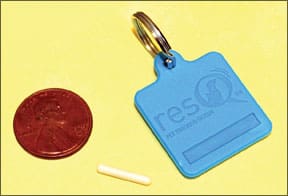
The AAHAs Universal Pet Microchip Lookup Tool relies on collaboration with microchip manufacturers and distributors, and so far supports only four of the main registries: AKC CAR (Companion Animal Recovery), HomeAgain, PetLink, and resQ. Three other registries Banfield, AVID, and 24PetWatch are not currently supported, but AAHA hopes to expand its coverage in the future.
When you enter a microchip number into the AAHA Universal Pet Microchip Lookup Tool, it tells you where that microchip has been registered, the registration date (which may not be accurate at this time), the registrys phone number, and a link to the registrys website. If a microchip number is not found in any of the supported registries, it gives you contact information for the most likely manufacturer and registries including ones not supported by the database.
Chloe Standard, a private start-up company in Mountain View, California, launched its website, ChecktheChip.com, in August. The company hopes to finance its operation with advertising.
According to a representative for Chloe Standard, the company asked various microchip registries for lists of their database numbers (minus owner information), but, the company says, the registries have been slow to respond. This means that in many cases Chloe Standard can identify only the chips distributor. When you enter a microchip number that is recognized, you are given the name of the registry, its phone number, and a link to the companys website. In cases where a number is not recognized, ChecktheChip provides contact information for six registries: AKC CAR, HomeAgain, PetLink (which is misidentified on the site as ResQ), 24PetWatch, AVID, and Banfield.
To be certain that your dogs identification microchip is properly registered to you, and your contact information is current, enter his microchip number into both search tools. If the registration is found, you should check with the registries to confirm that the contact information they have is up to date. AAHA suggests that you contact the registry directly if your registration is not found in its database.
Our tests indicate . . .
I entered several identification microchip numbers in both ChecktheChip.com and PetMicrochipLookup.org, with mixed results.
When I entered the number of a microchip that was issued in 1995 and enrolled in two registries, AAHAs website correctly identified both registries. ChecktheChip.com did not recognize the chip number. When I entered an AVID microchip number that had never been registered, AAHAs site was able only to identify the chip as an AVID product and gave me AVIDs phone number. ChecktheChip returned AVIDs contact information, implying that the chip had been registered there a confusing result.
I tested four HomeAgain chip numbers, only one of which had been registered. AAHA correctly identified the registered chip and returned a phone number for that registry; for the other three chips, it gave me the contact information of three likely registries (HomeAgain, AKC CAR, and PetNet in Canada) and the chips manufacturer, Digital Angel. ChecktheChip returned only HomeAgains contact information for all four.
Both databases are still in an early stage of development, but as of this writing, AAHAs Universal Pet Microchip Lookup Tool appears to be the more useful.
Mary Straus
For more information:
AAHA Universal Pet Microchip Lookup Tool: PetMicrochipLookup.org
Chloe Standard
ChecktheChip.com
Variety Is Important for Nutritional Completeness
Renowned nutritionist deplores reliance on single-recipe diets
Marion Nestle is the award-winning author of Pet Food Politics: The Chihuahua in the Coal Mine, the story of the massive pet food recall in 2007, and the upcoming Feed Your Pet Right: The Authoritative Guide to Feeding Your Dog and Cat, due out in May 2010. A renowned professor of nutrition, food studies, and public health, Nestles interest in nutrition extends to both people and pets.
In her Pet Food Politics blog, Nestle recently wrote about the limitations of nutrition analyses and databases as aids for creating healthy diets for people. I was surprised by how closely her words echoed my own feelings in relation to the drawbacks of relying on a single recipe developed with a spreadsheet to feed a dog.
Referring to the databases used to create these recipes, Nestle says, If you give it even a moments thought, you realize that the nutrient contents have to vary with growing location, soil conditions, climate, transportation, and storage, so the amounts given in the database can only be approximations of what you are actually eating [our emphasis]. The data arent meaningless, but they dont mean nearly as much as people think they do.
Exactly. Too many recipes created with spreadsheets, including those from veterinary nutritionists, provide only minimal amounts of important nutrients. If the foods used to create these recipes dont match up to the numbers in the database, the recipes are likely to be lacking in some areas. Feeding the same recipe and nothing else for long periods of time may lead to nutritional deficiencies.
The same problem can occur when you feed one commercial food exclusively. Foods that state they are formulated to contain complete and balanced nutrition for dogs may not actually do so for a number of reasons. These include how the food is stored; changes in the ingredient sources; and whether laboratory analysis of the food itself was conducted to confirm its nutrient content (as opposed to tests of a similar food from its maker, or a feeding trial to determine its nutritional adequacy).
I recommend choosing at least two or three different brands, using different protein sources, and rotating among them. If one food is deficient in some areas, the odds are that the next food will make up for it, especially if its made by a different company though that food may be deficient in other areas.
Spreadsheets have their place, especially when you need to control specific nutrients due to health problems. A spreadsheet can help you determine how to limit phosphorus in diets for dogs with kidney disease, for example. Even then, its safer to use multiple recipes that include different ingredients rather than always feeding the same recipe.
Nestle goes on to say, We know from studies using experimental animals that it is extremely difficult to induce nutrient deficiencies in animals that are fed a variety of foods providing sufficient calories. The best way to avoid nutrient deficiencies is to eat a variety of minimally processed foods. If you do that, you dont have to worry about specific nutrients.
Rather than relying on a single recipe created with a spreadsheet to ensure that your dogs nutritional needs are met, feed a wide variety of fresh foods in appropriate proportions; thats the best way to create a healthy diet for your dog, as well as for your family. Mary Straus
For more information:
foodpolitics.com, by Marion Nestle
New Pennsylvania Law Bans Five Home Surgeries
Law targets puppy mill operators and dog fighters; vets may still perform procedures
Late August headlines that blared about Governor Ed Rendell signing a bill banning ear-cropping, debarking, tail-docking, performing C-sections, and removing dewclaws were a little misleading, as the new law only applies to surgeries that are performed by non-veterinarians.
Rendell was quoted as saying, House Bill 39, which clearly defines the painful and inhumane procedures on dogs that constitute animal cruelty, takes the next important step for Pennsylvania in protecting dogs, said Rendell. Until now, these cruel practices could be carried out by dog owners without proper training and without supervision by a licensed vet, which could lead to long-term injury, pain and, in some cases, death to these defenseless animals.
Photo courtesy HCPHES 288
An owner who has these surgeries performed legally must now keep a record of the surgery, including the vet who performed it, as well as the location and date where the surgery was performed. Any person in possession of a dog upon whom any of the listed surgeries have been performed is in violation of the new law (not just the person who performed the surgery) unless they have a certificate from the veterinarian who performed the procedure, or a certificate from their county treasurer (at a cost of $1) showing that the procedure was done before the law became effective. Violation of the law is a summary offense, punishable by a fine of up to $300 and/or 90 days (maximum) in jail.
The new law further protects dogs by making it a third degree felony to steal or acquire in any manner an animal for the purpose of fighting. Pat Miller
Dogs Riding Safely and Calmly in Cars
Contrary to the advice I offer to clients and Whole Dog Journal readers, I admit that I’m sometimes careless about taking my dogs in the car with me. I don’t always use crates and seatbelts on short trips to town, although I always do on longer travels. Just recently, however, my husband and I loaded up all five of our dogs for their annual well-pet visit to a veterinarian, and I did take the precaution of crating everyone rather than risk canine chaos on the highway. Other than Bonnie’s panting, it was an experience in car-ride serenity, and I vowed to crate everyone, always, on future rides.

Granted, my dogs aren’t the worst in the car. They don’t sit in my lap, leap over seats, get into fights, hang out the windows, do laps around the back of the van, or bark at everything outside the car. Other than Bonnie, who pants a lot and sometimes Even so, they’re safer in crates. Loose, they are a distraction, which decreases my driving safety. Not as bad as texting, but still!
In case of an accident (heaven forbid!), loose dogs can become dangerous free-flying projectiles, slamming into seats or passenger’s heads, smashing into windshields, or escaping through broken windows to face highway hazards. Years ago, my brother lost his lovely Australian Shepherd this way; she survived the accident unscathed, but ran into highway traffic and was killed by a car. Also, loose, protective dogs can deter rescue workers from helping injured humans in the car.
At the very least, with a carload of crated dogs I don’t have to worry about someone forgetting their “Wait” training at our destination, leaping from the car when the door opens, and possibly getting hurt or lost.
So how do you take a dog who is accustomed to free range of your car when traveling, and turn him into an “easy rider?” You start outside the car.
Crates are Great
I personally prefer crates to seat belts; I think they’re safer. My dogs are all quite accustomed to crating, so it’s simply a matter of loading and securing crates in the van – that’s an important step that many people carelessly skip – and finally, putting the dogs in crates.
One small exception is Bonnie, who came to us with an aversion to riding in cars and sometimes still needs a little extra coaxing to “go to bed” in the car. With five dogs, I’d have to put the two back seats back into the van in order to use seat belts, and anyway, I find the prospect of getting all five into harness and buckled in place a little cumbersome. I can’t imagine how mothers of multiple small humans do it!
If your dog isn’t already crate-happy, you need to start there, with crate-training at home, before you can expect him to be happy about being crated in the car. (See “10 Quick Crate Training Tips”.) When your dog has come to love his crate, it’s usually a simple matter to transfer his crating behavior to the car, especially if he already loves car rides.
If your dog, like Bonnie, finds the car aversive, you’ll need to work on that piece first – but you can work on it at the same time you’re teaching him to love his crate in the house. Just don’t put them together until he loves both. When he’s happy to run into his crate and stay there, and when he’s happy to hop into the car on cue, then put the crate in the car and work on them together. When that’s working well, you’re ready to start the engine.
Seat Belts are Spiffy
There are times when seatbelts are a better option. If your car is smaller than your dog’s crate, you have no choice. If, despite your best efforts, your dog hates crates, a harness and seatbelt will be easier for you and less stressful for him. If you prefer seatbelts, there are several good products on the market. Each has strengths and weaknesses, so be sure to study up and select the one you think best meets your dog’s needs. (See “(Seat) Belt Your Dog,” February 2004). Your dog should ride in the back seat when belted; air bags can be as deadly to canines as to young children. Alternatively, if he must ride in front, disable the airbag and make sure the seatbelt arrangement doesn’t allow him access to the driver’s lap. Features of the best seat belt products include:
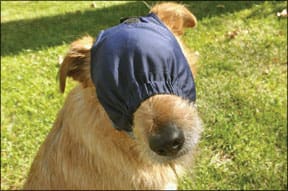
• A strap that hooks directly into the seatbelt mechanism rather than loops over the belt, to minimize belt play and reliance on the seat belt mechanism should you stop suddenly. (Note: It may be difficult to find products that offer this feature.)
• Good quality parts and materials that can hold up in case of impact.
• Reinforced stitching at stress points.
• Options for customized fit.
• Easy to put on the dog.
• Comfortable for the dog.
When you have identified and purchased the best seat belt for your dog, take time to acclimate him to the apparatus well before you intend to use it. This is accomplished by classically conditioning him to the harness itself, then giving him a positive association (treats!) with wearing it, and ultimately being strapped into his seat.
To condition your dog to the harness, have him target his nose to it. Hold out the harness toward him, and when he sniffs it, click a clicker (or mark the moment with another reward marker such as the word “Yes!”) and quickly give your dog a treat.
When he’s eagerly touching his nose to the harness, hold it so he can put his head through it, and click and treat him for that. You may have to ask him to target through the opening to your hand at first, but he should quickly start offering to “put it on” himself. (For more on target training, see “Right on Target,” February 2006).
Note: For an excellent video on conditioning a dog to a piece of training equipment, go to abrionline.com, click on “Videos and Podcasts” and then on “Conditioning an Emotional Response.” You will see trainer and author Jean Donaldson conditioning her Chow-mix, Buffy, to a head halter – not my favorite piece of equipment, but the principle and procedure is the same.
Training Tips
If for some reason you simply cannot crate or belt your dog safely in your car, at least take the time to train him to ride quietly, and do not let him hang out the window.
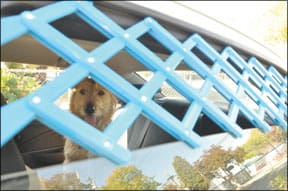
Again, start outside the car by making sure you’ve trained a solid “down” and “wait” or “stay” (see “Wait Versus Stay,” April 2009). Then practice in the car, with the car sitting still, engine off, you in the driver’s seat, your dog in the back seat. You can reinforce his down at first with treats, but fade the treats as quickly as possible and replace them with calm praise – you won’t be able to reinforce with treats while you’re driving!
When your dog will lie on the back seat quietly for 10 to 15 minutes while you read a book, start the engine. That may be enough to get him excited; if so, practice having him lie down in the back-seat with the car’s engine running yet parked, preferably in a shady and well-ventilated area!
A Few More Car Thoughts
There are a number of products and practices that can improve the quality of your and your dog’s car-travel experiences:
• Covered crates: Another benefit of the crate is that you can cover it. If your dog is reactive to stimuli outside the car, a cover over his crate can make life happier for everyone – he doesn’t react to what he can’t see, he stays calm and below threshold, and you aren’t startled while driving by his sudden outbursts.
• The Calming Cap: For a reactive dog who is either loose or seat-belted in the car, the Calming Cap is a useful tool for reducing arousal to outside stimuli. The Calming Cap, created by Trish King (training director at the Marin Humane Society) for use with dogs who get over-aroused in cars, is a sheer nylon hood that covers the dog’s eyes. He can see shapes but not detail, so he’s less reactive to the reduced intensity of the stimulus. Calming Caps are available from Premier Pet Products, premier.com or (800) 933-5595.
• Exercise: A tired dog is a well-behaved dog. A well-exercised dog is far more likely to behave well (and safely) in your car than one who is brimming with energy. Give your dog a good workout before you take him in the car, at least until his car manners are solid. If you can’t do a good physical workout, tire him mentally with brain games (see “A Puzzling Activity,” June 2008).

• Open windows: Everyone knows dogs like to stick their heads out car windows. Not everyone knows how hazardous that can be. Debris can fly into your dog’s eyes at high speed and cause injury, even blindness. “Doggles” – goggles for dogs – can help protect his eyes, but there are other hazards. Your dog can also ingest harmful particles through his nose and mouth.
A dog who hangs out a car window can suffer far worse than getting hit by a bit of airborne debris – he can fall out of the car! I was driving through downtown Hagerstown one day, behind a car with a Beagle hanging out an open window. Just as I thought, “Uh-oh, that’s scary,” the little dog fell out of the window onto the road in front of my car. I slammed on the brakes, pulled over, and helped the driver retrieve his thankfully unharmed dog.
If you must leave car windows open for your dog, please install one of several safety products designed to prevent such accidents such as the Breezeguard (an expensive but well-made product, available from muttmanagers.com, 866-653-5631), or a Vent Guard (an inexpensive but much less secure item, available in many pet supply chain stores and online outlets).
• Calming products: I spray Comfort Zone/DAP, a stress-reducing product, in Bonnie’s crate to help reduce her stress. Calming aromatherapy products (especially lavender) misted in your car may also help keep your dog calm. Also consider an Anxiety Wrap (available from anxietywrap.com, 260-344-1217) or even a snugly fitting T-shirt; this sort of swaddling can calm anxious dogs.
I’ve also seen good results from playing one of the “Through a Dog’s Ear” audio CDs for an anxious dog. A company called BioAcoustic Research and Development has developed four music CDs meant to calm anxious dogs, including one just for driving with dogs. The “driving edition” also includes some helpful instruction on preparing your dog for a calm car ride. These are available throughadogsear.com, (800) 788-0949.
Pat Miller, CPDT, is Whole Dog Journal’s Training Editor. Miller lives in Fairplay, Maryland, site of her Peaceable Paws training center. Pat is also author of The Power of Positive Dog Training; Positive Perspectives: Love Your Dog, Train Your Dog; Positive Perspectives II: Know Your Dog, Train Your Dog; and Play with Your Dog.
How to Identify and Pick Top Quality Dog Treats
[Updated March 6, 2018]
Surely there is no such person as a dog owner who never gives his or her dog a treat. We all like to see our dog’s tail wag, and his face light up with attentive anticipation, right?
But how do you know that the treats you give him are healthy? It’s actually pretty simple. As with every food you buy (for yourself or your dog), it’s all about the ingredients.
If you do not already read the label of every food item you consider buying, get in the habit! Most of the information you need to know in order to determine the product’s quality is legally required to appear on the label.
Want to throw together your own homemade dog treats? Try these homemade recipes.
What to Look for in Dog Treats
We suggest that you start with the ingredients list. Ingredients are listed on the label by weight; there is more of the first ingredient on the list present in the treat than the second ingredient, and so on. (One exception: If equal amounts – by weight – of different ingredients are present, the manufacturer can list those ingredients in any order; that is, as long as they are still in order relative to the other ingredients). The first few ingredients on the list are the most significant; since they comprise the majority of the content, they should be especially high in quality.

What constitutes quality in a pet food ingredient? Actually, the same attributes that indicate quality in human food denote quality in pet food. Top-quality ingredients are as fresh, pure, and minimally processed as possible; whole food ingredients are better than by-products or food “fractions.” For example, “wheat” is better than “wheat flour.” “Wheat flour” is better than “wheat bran and wheat germ.” The more highly processed and reconstituted an ingredient is, the more opportunities it has for adulteration and contamination, and the more nutrients it loses.
It stands to reason that the freshest ingredients available to U.S. food makers will be grown in the U.S. While some manufacturers argue that their oversight of foreign ingredient providers is reliable, we strongly prefer domestic ingredient sources. The only exception may be those ingredients that are near-impossible to obtain from U.S. sources, such as free-range, organic venison. Even so, if we found a treat that contained domestically sourced free-range, organic venison, we’d favor it over a product containing free-range, organic venison from New Zealand.
Ingredients that are sourced as close as possible to the manufacturer (locally sourced ingredients) are good. Again, they are necessarily fresher than ingredients that require shipping from across the country. That’s good for the environment, too.
Every ingredient on the label should be an easily recognizable food; there should be no question what the source is. For example, “meat meal” or “animal fat” could come from just about anywhere. In contrast, “chicken” comes from chickens, and so does “chicken fat.” If you can’t determine what species of animal a meat or fat came from, you should not feed it to your dog.

Organic ingredients are good; they are less likely to be adulterated with contaminants, and they receive extra scrutiny from inspectors. The more organic ingredients, the better.
If a sweetener is used, it should be natural and food-based, and used in moderation. Applesauce, molasses, or honey are better than artificial sweeteners. We disapprove of any sweeteners in dog food, but we’re talking about treats here: something the dog may not get every day, and something he’ll get only a few of. A little natural sweetening in a treat is okay.
If a treat is preserved, it should contain a natural preservative. Vitamins C and E (the latter is listed as “mixed tocopherols”) are effective and safe preservatives. Some treats contain no preservatives at all; these should be stored properly and used promptly.

Meaty Treats
The most obvious characteristic of a meaty treat is its high animal protein content. Animal muscle and organ meat ingredients are much more expensive than grain- or vegetable-based products, so meaty treats will generally cost more than other types of treats.
Products may be quite dry (with a moisture content around 5 percent); or chewy, with as much moisture as 25 percent. The moist products will necessarily contain ingredients known as “humectants” — substances that promote the retention of moisture in the product. The low-moisture treats may be dried, freeze-dried, or dehydrated.

1)]
In general, the fewer ingredients used in meat-based dog treat products, the better.
Cookie or Biscuit-Style Treats
In general, cookie- or biscuit-style treats are made with grain or another carbohydrate and baked. That said, this is a wide category of treats, and there are many grain-free products on the market.
Some biscuits use animal products (such as muscle meat, organ meat, fat, dairy products) as the principle palatant (ingredient used to appeal to dogs), but others use sweeteners or salt.
This style of product generally has the same range of moisture content found in dry dog foods — about 10 to 12 percent.
In general, the fewer number of least-processed ingredients used in these products, the better.

Dog Treat Ingredients to Avoid
While you are examining the list of ingredients for quality components, make sure the treat does not contain any of the following:
• Artificial preservatives, including BHA, BHT, ethoxyquin, potassium sorbate, sodium nitrate (used for dual purposes, preservative and coloring), and calcium propionate should be avoided.

• Artificial colors. Color is added to dog treats to appeal to you; your dog doesn’t care what color the treat is! You aren’t going to eat these treats, are you? So don’t buy treats that contain these unnecessary (and many believe unhealthy) chemicals.
• Chemical humectants, such as propylene glycol. These are used in some pet (and human!) foods to keep them moist and chewy, and to prevent discoloration in preserved meats. There are more natural, food-sourced humectants available, such as vegetable glycerin and molasses.
Speaking of glycerin: If it’s not identified as “vegetable glycerin” (a food-sourced product), it’s likely to be a petrochemical product – not good.

0)]
Other Admirable Traits
There are many other factors that we consider when buying treats, but these don’t quite rise to the level of make-it-or-break-it selection criteria. However, they are attributes we appreciate for their benefits to our dogs, all dogs, and the planet we all share.
• We like to see products with recycled (and/or recyclable) and minimal packaging.
• We seek out treats that are either small, or easy to break into small pieces. When you use a lot of treats for training, they should be small, so you don’t ruin your dog’s diet.
• We admire companies that simply list the ingredients in their products, without splashing the ingredients they don’t contain all over the label, as in, “No soy, wheat, or corn!” Many dogs do just fine with soy, wheat, corn, and other ingredients that some food makers try to marginalize. (Please consider that there is a difference between a label that boasts, “No artificial colors or preservatives!” and one that says, “No corn!”).

2)]
• On a related note, we get aggravated every time we see a label claim that a treat is “hypoallergenic” or “contains no allergens.” Any food ingredient can be an allergen; there are dogs who are allergic to eggs, chicken, beef, fish, pork, lamb, rice, barley, quinoa, and any other food you can name – foods that are perfectly appropriate for most dogs.
• We appreciate companies that donate a percentage of their sales to dog-related charities.
The Caloric Content of Treats
It’s long been one of my pet peeves that dog food manufacturers are not required to put the caloric content of their products on their labels. It seems that many food makers don’t seem to think that dog owners are smart enough to use this information to help determine how much their dogs should be fed in order to maintain a healthy weight. (I’m sure some aren’t, but hey! Some are!)
I applaud the pet food companies that do include the caloric content on the label voluntarily — which means the treat manufacturers that include this information should get a standing ovation.
Why should treat makers get extra credit? Because treats are, by their very definition, more desirable and delicious than regular food. And dog treat makers frequently achieve “desirable and delicious” the same way that human treat makers do: with extra fat, sugar, and salt. Fat is the worst offender in terms of adding calories; a gram of fat contains about 9 calories. In contrast, a gram of carbohydrate or protein contains about 4 calories. Salt, of course, is noncaloric.
However, the more palatable a treat is, the more a dog will want it, and the harder he will work to get you to give him more than he really should receive.

4)]
“No problem!” some people say. “I’ll just reduce how much of his food I’ll give him!” He may need to have his total food intake reduced a bit anyway, but in general, it’s a bad idea to replace more than about 10 percent of his nutritionally “complete and balanced” diet with a decidedly not complete and balanced food (some vets suggest no more than 5 percent of his diet). Few treats are formulated with vitamins and minerals in the proper amounts and ratios, based on their calorie content, to represent a properly “complete and balanced” contribution to your dog’s diet. If incomplete and unbalanced treats replace a significant portion of his complete and balanced diet, it follows that your dog won’t receive all the nutrients he needs.
So, how much should you feed your dog, and how will treats affect that? As author Mary Straus explained in “Helping Your Dog Lose Weight,” “Resting energy requirement (RER) is the number of calories per day your dog requires for just basic needs . . . To determine your dog’s RER, convert his ideal weight in pounds to kilograms by dividing by 2.2, then multiply that number by 30 and add 70.”
For example, for my dog Otto, I would use 65 pounds as his ideal weight. I divide this by 2.2 (which is 29.54 kg). Multiplied by 30 plus 70 is 1,026.36 calories — Otto’s RER. I want to make sure that no more than 10 percent (rounding a bit, 103 calories) of these calories are treats.

5)]
Well, Otto’s favorite treat is hot dog, and the ones I buy to use for his training treats contain 130 calories per hot dog. Yikes! When we go for a walk or to a training class, I generally bring two hot dogs. I cut them into many tiny pieces, but still, on these days, he’s getting more than 25 percent of the calories he should be eating in one day from an extremely unbalanced and certainly incomplete food.
So, why isn’t Otto hugely fat — or showing the signs of nutritional deficiencies? To answer the former, on the days when we walk or train, he gets a lot more exercise — enough to burn off the extra calories. As to the latter: I’ve only had him for a year and a half — and he certainly doesn’t get two hot dogs every day! But I should definitely adjust this treat habit — start mixing in some lower-calorie treats, and saving the really fatty hot dogs for just the most difficult behaviors I want to reward — before it results in health problems brought on by nutritional deficiency.
These are the sort of things you should be considering when you make treats a regular part of your dog’s diet. Do the math; it’s not that difficult! And look for the caloric content on the label of your favorite treats. If it’s not there, check the company’s website, or call them and ask. If they can’t give you the information, don’t buy that treat! It’s my basic information that they should know and be willing to share.
Our List of Approved Treats
We’ve listed a number of companies that make treats that meet all of our selection criteria. Be aware that we do not rate or rank-order the treats we have highlighted as examples of good products. A treat either meets our selection criteria (as outlined above) or it does not; there is no “top pick” or “best on the list.” We suggest that you try a variety of products, and keep track of which types your dog likes best and which don’t agree with him (so you can avoid them in the future).
Don’t fret if your top pick is not on our list; if it meets our selection criteria, it’s as good as anything we’ve highlighted below. Happily, there are many more good products on the market than we could ever list!

Top-Quality Meaty Dog Treats
Meaty treats vary quite a bit in consistency, since some are dried and others are dehydrated or baked. Also, some contain only meat: others contain grains or other carbohydrates on the ingredients list (below the meat ingredients).
BELLYRUBS DOG TREATS
Meyer Country Farms
Scottsdale, AZ
(480) 614-1869

3)]
CANINE CAVIAR
Canine Caviar Pet Foods, Inc.
Costa Mesa, CA
(800) 392-7898
CARNIVORE CRUNCH
Stella & Chewy’s
Muskego, WI
(888) 477-8977
DR. BECKER’S BITES
Dr. Becker’s Bites
St. Anne, IL

ETTA SAYS! MEATY TREATS
Etta Says!
Seattle, WA
(866) 439-3882
GRIZZLY NUTREATS
Grizzly Pet Products, LLC.
Kirkland, WA
(888) 323-5575
L1V-A-LITTLES
Halo Purely for Pets
Tampa, FL
(800) 426-4256
MEATY BITES
Addiction Foods, NZ Limited
Te Puke, New Zealand (U.S. distributor is Evergreen Pet Supply)
NOTHING BUT…TREATS
A Place for Paws
Columbiana, OH
(800) 354-4216
PRIMAL DRY ROASTED TREATS
Primal Pet Foods, Inc.
San Mateo, CA
(866) 566-4652
WELLNESS PURE REWARDS AND WELLNESS WELLBITES
Wellpet, LLC., Inc.
Tewksbury, MA
(800) 225-0904
WHOLE LIFE PET TREATS
Whole Life Pet Products
Pittsfield, MA
(877) 210-3142
ZIIMPEAK GOOD DOG TREATS
Ziwipeak Ltd.
North Island, New Zealand
(877) 464-9494
ZUKE’S TREATS FOR DOGS
Zuke’s
Durango, CO
(866) 985-3364
Top-Quality Cookie Treats

7)]
Cookie- or biscuit-style treats tend to have a more consistent texture, thanks to their baked carbohydrate content. But because the dough can be rolled and cut out, bakers can design an unlimited number and variety of creative shapes and sizes. As cute as the larger cookies are, we strongly prefer small treats – or at least cookies that can easily be broken into hits.
BARKSTIX
Bark Stix
Pt. Richmond, CA
(510) 235-2430
BUDDY BISCUITS, MUTTOS, PROVENANCE, TRAILHOUND
Cloud Star Corporation
San Luis Obispo, CA
(800) 361-9079

CHARLEE BEAR DOG TREATS
Charlee Bear Farms, Inc.
Madison, WI
(800) 980-2327
FRUITABLES
Vetscience, LLC.
Dallas,TX
(214) 800-2321
GRANDMA LUCY’S DOG TREATS
Grandma Lucy’s
Irvine, CA
(800) 906-5829
HOWLIN’ GOURMET
Dancing Paws Bakery
Tustin, CA
(882) 644-7297
MA SNAX SUPERIOR TREATS
Ma Snax
Sonoma, CA
(707) 9398174
MOTHER NATURE NATURAL DOG BISCUITS
Natura Pet Products
Santa Clara, CA
(800) 532-7261
NEWMAN’S OWN PREMIUM DOG TREATS
Newman’s Own Organics
Aptos, CA
(800) 865-2866
PAWS GOURMET
Paws Gourmet, Inc.
Marysville, WA
(866) 231-7297
SMOOCHES, NUZZLES, and PECKS
The Honest Kitchen
San Diego, CA
(866) 437-9729
SOJOS DOG TREATS, GOOD DOG TREATS
MONZIE’S ORGANIC COOKIES FOR DOGS
Sojourner Farms
Minneapolis, MN
(888) 867-6567
TOY TEMPTATIONS
Dogchewz NYC
New York, NY
(212) 722-5855
WAGATHA’S BISCUITS FOR DOGS
Wagatha’s
Manchester Center, VT
(802) 367-1010

6)]
WAGGIN’ TAILS COOKIES
Waggin’ Tails Bakery
Santa Rosa, CA
(707) 569-9425
WET NOSES HERBAL DOG TREATS
Wet Noses Dog Food Co.
Snohomish, WA
(866) 938-6673
Another Sort of Treat

These two treats are not meat-based but they are not cookies. either! Both contain a single-ingredient: Dried sweet potato.
DR-CHEW SWEET POTATO TREATS
Landy Corporation
Federal Way, WA
(253) 835-1427
SAM’S YAMS
Front Porch Pets, Inc.
Henderson, NV
(800) 922-2968
DOG TREATS: OVERVIEW
We make it a point to say this every single time we discuss treats: Don’t buy dog treats at the grocery store, unless you also do each of the following:
1. Read the ingredients panel of any treat you consider buying. Pass it by if it contains artificial preservatives and/or colors, animal products from unnamed species, or animal by-products.
2. Check the ingredients list for foods your dog may be allergic to or intolerant of.
3. Don’t forget that you can use real, fresh food for treats! Offer your dog bits of cheese, cooked meat, and pieces of fruit and vegetables, and determine which he likes best.
Dancing With Dogs
Snapping fingers and tapping feet are the signature moves of musical freestyle – and that’s the audience! What happens between dog and handler during a musical freestyle performance is simply magical. The handler gives subtle cues, and her dog executes complicated maneuvers, one after the other, as the pair moves across the floor, their routine choreographed to music that emphasizes their connection.
For those of you whose introduction to this sport was watching a widely distributed video clip of Carolyn Scott’s routine to “Grease” with her Golden Retriever, Rookie, you were probably awestruck. You may have even gotten a little misty eyed, recognizing the commitment, training, and connection between two different species. But it was the look on Rookie’s face that sold you that this was a sport worth exploring. This dog was having a blast, and the behaviors he was doing were difficult! How could training something so hard be so fun?

Photo by Brenda Cutting
288
“I first saw freestyle in 1997, a video of Donna Duford and her PBGV (Petit Bassett Griffon Vendeen),” recalls freestyle judge and instructor Julie Flanery. “In 1998 I saw it live for the first time at a demonstration at an APDT (Association of Pet Dog Trainers) conference. I was amazed at what these dogs were doing and how much fun it looked. I had to do this with my dog!”
Flanery has since become one of the sport’s most ardent boosters, convincing many people to give this sport a try even in the sport’s early days in her area of the Pacific Northwest. “Most of my early freestyle training was on my own by watching others and then figuring out how to train it using positive reinforcement methods. I had to do a lot of problem solving early on and came up with several of my own methods. I also took several workshops, sometimes traveling great distances to learn from top performers.”
Flanery added freestyle to the list of classes she was teaching at the time, cajoling several of her students to give it a try. “That small group of six friends created the first freestyle club on the West Coast, Dogs Gone Dancin,’ now with almost 50 members in Oregon, Washington, and British Columbia.”
Since then, Flanery has stayed so active in the sport that she has been invited to present workshops in South Africa, has presented numerous workshops in the U.S., has become a judge for the World Canine Freestyle Organization (WCFO), and, of course, put advanced freestyle titles on her own dogs. All from just watching that one demonstration. Watch out; this sport can be addictive!
The game
There are two major styles of dog dancing, as this sport is also known. One is heelwork to music, or canine dressage, which focuses on setting precise heelwork (in close to proximity to the handler) to music. Musical freestyle, on the other hand, allows any movement or combination of movements, in close proximity or at a distance, as long as the movements are safe for the dog.
Music is chosen based on a dog’s gait, with faster tempos for the quick-moving dogs and a more moderate beat for dogs that naturally move slower or are larger in structure. Handlers memorize the music, break it down into segments, choreograph movements for themselves and their dogs, and then string it all together. The result can be breathtaking, hilarious, dramatic, or a combination of all three.
If you have never seen a freestyle routine, you might want to power up your computer, go to YouTube.com, and type “canine musical freestyle” in the “search” field. You’ll find a wide variety of clips. Carolyn Scott’s “Grease” routine has had more than 5 million viewers. Look at a few of the “most viewed” clips and you’ll see why this sport is so fun and challenging.
At its core, musical freestyle is the art of training individual tricks such as spin, twist, back up, leg weaves, circling around the handler, side stepping, etc., and then training your dog to do multiple tricks in a row while you move around at the same time. Cindy Mahrt was one of the people Flanery enrolled in one of her classes in 2000. Mahrt attended with her 18-month-old Rottweiler, Gitta.
“I wanted to keep Gitta in some sort of class to keep up her socialization skills,” recalls Mahrt. “Gitta and I had gone through all the normal classes – puppy, beginners, advanced beginners; we even tried a tricks class. When Julie decided to try a freestyle class, she asked if we were interested. It was way more fun than doing basic obedience over and over. A small group of us tried it one night; it was a little crazy, but fun, and I was hooked.”
Mahrt had never competed in a dog sport before and had no intention of doing so in freestyle. However, Flanery’s enthusiasm was infectious and Gitta just loved the sport. “I swore I would never compete,” says Mahrt. “I just couldn’t see myself going out in public and dancing with my dog in a costume. I wasn’t comfortable with the whole idea of competition. I just wanted to have fun with Gitta and the friends I’d made in class. At that time, there weren’t many opportunities to compete, so it wasn’t much of an issue.”
History
Freestyle in North America goes back to 1989 when Val Culpin of British Columbia, Canada, started developing the sport. Trainers in England were on a similar path, with top obedience competitor Mary Ray wowing crowds with her demonstrations at Crufts, the top conformation, obedience, and agility competition event in Britain.
Throughout the 1990s, the sport continued to grow in Canada, the U.S., and Britain. The Canada-based Musical Canine Sports International (MCSI) was launched to write rules and judging guidelines. Its first U.S. competition was held in 1996 in Springfield, Oregon.

Rainbow River Photography
288
Throughout the years, different styles of the sport developed, including heelwork to music and musical freestyle, as well as a distinctly theatrical style with highly costumed competitors and dramatic story lines. Bring up YouTube.com on your computer’s Web browser again and search “Attila and Fly, Gladiator” for an excellent example of this more theatrical style. The sport has continued to evolve throughout the world, and additional organizations have sprung up to support different approaches and philosophies. (See Snapshot of the Sport, below.)
Attributes of dancing dogs and handlers
A wide variety of breeds and mixes participate in this sport. Freestyle training is great for fearful dogs, too, since only one dog competes at a time, and the training culture in freestyle is one of using positive reinforcement methods.
Positive methods help build dogs’ confidence and trust, and this was an attraction for Mahrt when she decided to try freestyle. “Gitta really responded well to positive reinforcement training. When we first started [obedience] classes, it was mostly positive, but switched back to traditional methods when any problems arose. This just didn’t work with Gitta; it only made things worse. It was wonderful to start freestyle and switch to only positive reinforcement. We do a lot with clicker training and shaping.”
Flanery believes that freestyle appeals to many kinds of people, but especially “those who enjoy music, enjoy the teamwork between dog and handler, who seek a creative outlet for themselves and their dogs, and who are willing to step outside of their current skill set and learn new things, such as music editing, choreography, and presentation.”
Equipment & supplies
Although some trainers use some props in their routines (e.g., a cane, a stool, a handkerchief), all that is required is you and your dog. With the exception of the more theatrical routines, costumes are not essential although most people dress in a manner that supports their routine. For example, a team performing to country music might wear a western-themed shirt and jeans.
You will need a boom box or other music player to play your music, and it is helpful to have one that is easy to pause, rewind, and find your place again. A remote control can be helpful for this. Handlers use pen and paper and sometimes rally obedience signs and software to map out their choreography. Otherwise, standard training supplies (clicker and treats) are all you need.
Expenses
This is a relatively inexpensive sport. Gas and lodging will probably be your biggest expense if you intend to compete in person. If you can find a class in your area, they are typically similar in cost to basic pet manners classes. An alternative to a freestyle class is to enroll in a tricks class to build your repertoire of behaviors.
Competition fees run about $30 per class per event. Live competitions are still far and few between so you might compete only once or twice a year, and video competitions are only scheduled a few times a year as well. Membership in one of the sponsoring organizations varies. For example, an annual membership in the WCFO is $30.
Training
This is a deceptively difficult sport. It looks like so much fun that one forgets that each behavior must be trained to mastery before putting them together in a routine.
Professional trainers like to say, “A behavior chain is only as strong as its weakest link.” If one of your behaviors, e.g., leg weaves, falls apart in the middle of a routine, it can be difficult to get the routine back on track.
Flanery points out, “As freestyle competitors we are asking our dogs to perform anywhere from 30 to 80 (or more!) cued behaviors in a span of a minute and a half to four minutes depending on the level entered . . . there is a lot of multi-tasking that goes on in the freestyle ring. Both the dog and the handler are working hard. The dog, attentive, following cues and performing with as much precision as possible, always ready for the next cue; the handler, listening to the music cues, cueing the dog’s moves, keeping her choreography straight, and readjusting for missed moves or cues.”
The prerequisite behaviors that set teams up for success are those brought from basic pet manners: attention, sit, stay, down, and heel (walk in position next to you). Of these, attention and heel in position are the most important. While polishing those basic skills, you can also be training a variety of tricks, the foundation of what you see in a freestyle routine.
Most important for handlers who want to excel in freestyle is a solid understanding and hands-on experience with positive reinforcement and, in particular, clicker training. The clicker excels as a “behavior marker,” quickly and accurately (in the hands of a skilled trainer) identifying the smallest pieces of a full behavior that might be difficult to get with other methods.
For example, imagine that you want to train your dog to lift a front foot off the floor and hold it in space for two seconds. It might be difficult to lure that behavior (using a treat to move your dog in the direction you want). With the clicker and good observation skills, you can click for the slightest shift of weight. Dogs that have been clicker trained understand that the click happened for something very specific and they soon figure out what it is. The art of “shaping” behavior this way also makes it easier to motivate your dog to work with you even if you don’t have a treat in front of her nose.
Flanery has used a combination of luring and clicker training to train many of the creative and complex behaviors she has taught over the years. “While there are freestylers who don’t use a clicker, I believe strongly that to get to the upper levels of creativity, a dog and handler team should focus on building solid clicker skills and an understanding of operant conditioning. It is often the dog who comes up with the most creative behaviors, and if you don’t understand how to draw that out of your dog, then you are missing out on one of the most amazing aspects of freestyle.”
Training freestyle, even if you choose not to compete, has additional benefits. As with many dog sports, an amazing connection between human and dog blossoms through the training process. This is especially true for dogs with behavior issues or physical challenges. Cindy Mahrt’s Rottie, Gitta, had both. Now 11 years young, Gitta’s freestyle training was interrupted in 2003 when she underwent anterior cruciate ligament knee surgery at age five and then a year later for the other knee. She had also always been a bit fearful, and being out of commission for almost two years for her surgeries and recovery was a set back for Mahrt who had worked so hard to train and socialize her dog.
“We suddenly were very restricted in what she could do for those couple of years. Freestyle is a great sport for building up muscle tone. Dogs do a lot of rear work – backing up, side passes, circling around backward, backward weaves, etc. All of these take an awareness of their rear ends that most dogs don’t have. I think it really helped her recovery.
“Being sidelined by two surgeries kept her pretty isolated for awhile. Gitta is very reactive to dogs she doesn’t know. Freestyle got me working with clicker training and positive reinforcement. They are very useful and important tools in dealing with a reactive dog. Giving her something else to focus on is also important. If a new dog comes into class, I can have her do spins, circles, weaves, etc., and get a big treat; she forgets all about the other dog. Pretty soon that dog isn’t so scary anymore.”
Levels of competition
Each organization has its own rules for heelwork to music and musical freestyle. Judging takes into consideration creativity, variety, and audience appeal. Specifics such as how much floor space must be covered in a particular level or division will be covered and guidelines provided that help handlers decide the number of behaviors they want to showcase in a given performance.
Both WCFO and MDSA have a system for handlers to submit videotape of their performance for judging, so you can “compete” without having to always travel long distances.
What if you don’t want to compete? Many people start out thinking that competition is not their cup of tea. Mahrt remembers her own reluctance to compete. “Then I figured I could at least try it, once, but without a costume. I guess you can see where this is going,” Mahrt says wryly. “Although I don’t have a fancy costume – I usually wear nice black trousers and a velvety black shirt – I do now compete. I think it was 2001 that we had our first competition in Washington. We did pretty well; that was our first beginner’s leg. It took a long time after that to get the next leg and move up the ladder. The surgeries and stage fright – hers, not mine (well, a little mine) – slowed us down for a while.
“We compete through WCFO in live competitions. We got our Beginner and Novice titles. It then became obvious that physically she could not compete any longer in the regular divisions. WCFO is a great organization for its inclusion of everyone. I’m happy to say that Gitta and I earned our Championship title in the Handi Dandi division last May. We are now going to start over in the Sassy Senior division, for dogs older than nine years.”
How to get started
Contact one of the sponsoring organizations to find out if there are any instructors or member clubs in your area. If there aren’t, do what Julie Flanery did. Watch some videos, get inspired, and share your enthusiasm with your friends. Many freestyle groups start when friends meet at a park and train together, sharing music, tricks, and choreography tips. Find a local clicker trainer or training facility that uses positive reinforcement and, if they don’t offer freestyle, convince them to bring someone in to present a seminar to get you started.
Is this sport for you?
There are many aspects of freestyle that may appeal to you: the fun in just spending time with your dog, the challenges of competition, or sharing your routines with nursing home residents through therapy dog visits or doing public demonstrations. This is truly a sport that, at its core, expresses the deep potential within the human-canine bond.
Now, go grab those dancing shoes!
Terry Long, CPDT, is a writer, agility instructor, and behavior counselor in Long Beach, CA. She lives with four dogs and a cat and is addicted to agility and animal behavior.






